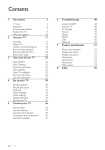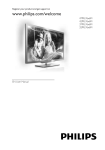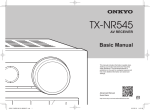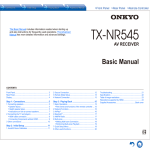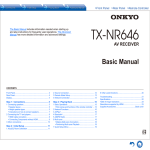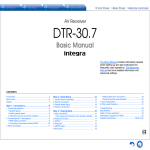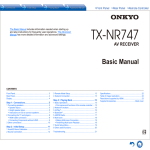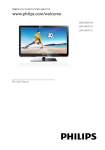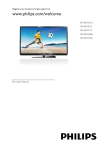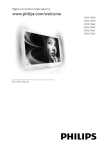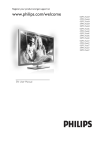Download Philips 42PFL8606D 42" Full HD 3D compatibility Smart TV Stainless steel
Transcript
Register your product and get support at
www.philips.com/welcome
42PFL86x6D
47PFL86x6D
EN User Manual
Contents
1
2
3
4
5
EN
Get started
3
TV tour
Important
Environmental efforts
Position the TV
Help and support
3
6
8
9
11
Use your TV
12
Controls
Watch TV
Watch a connected device
Watch 3D
Ambilight
Browse PC through DLNA
Browse Net TV
Rent online video
12
15
18
19
20
21
23
25
Use more of your TV
27
Digital TV interactive
Pause TV
Games
Set locks and timers
Display closed caption
View Scenea
Set universal access
Use EasyLink
27
27
29
30
31
31
32
33
Set up your TV
36
Settings assistant
Picture and sound
Channels
Menu language
Other settings
Update software
Reinstall the TV
36
36
37
39
39
40
41
Connect your TV
42
About cables
Connect devices
Connect more devices
Computers and the Internet
42
43
50
53
2
6
7
8
Troubleshooting
57
Contact Philips
General TV
TV channel
Picture
Sound
HDMI
USB
Network
57
57
57
58
58
59
59
59
Product specifications
60
Power and reception
Display and sound
Display resolutions
Multimedia
Connectivity
Dimensions
Help version
60
60
60
61
62
62
63
Index
64
English
1 Get started
TV tour
Remote control
To open or close the Find menu.
In the Find menu, access the channel list.
To adjust the volume.
To open or close the Adjust menu.
In the Adjust menu, access a range of
frequently used settings.
To switch TV channels.
To open or close the Options menu.
Options menus offer convenient settings for
TV channel or program.
To open or close the Home menu.
In the Home menu, access connected
devices, picture and sound settings, and
other useful features.
To return to the previous menu page or to
exit from a TV function.
Press and hold to return to watching TV.
To open or close the Source menu.
In the Source menu, access connected
devices.
To exit from menu or TV function.
EN
3
Connect devices
To select a red menu option, access Digital
Interactive TV services*, or watch TV
demonstration clips.
*Available on certain models only.
To select a green menu option or to access
energy efficient settings.
To select a yellow menu option or to access
the electronic user manual.
Read more about the remote control in Use
your TV > Controls > Remote control
(Page 12).
Alternatively, look at the index in Search
for...
Press
EN
to select the next TV tour.
4
For the best picture and sound quality,
connect a DVD, Blu-ray disc player, or game
console through HDMI (TM).
To watch a non EasyLink compliant device,
add it to the Home menu.
1. Press > [Add your devices].
2. Follow the onscreen instructions.
Note: If you are prompted to select the TV
connection, select the connector that this
device uses. See Connect your TV >
Connect devices (Page 43) for information
on connection.
If an EasyLink or HDMI-Consumer Electronic
Control (HDMI-CEC) compliant device is
connected to the TV, it is automatically
added to the Home menu when both
devices are switched on.
To watch a connected device
1. Press .
2. Select the newly added device icon.
English
You can learn more on device connections in Connect your TV > Connect devices.
High Definition TV
Ambilight
For high-definition (HD) picture quality,
watch HD programs.
On standard-definition (SD) programs, the
picture quality is standard.
You can watch HD video content in these
ways and more:
a Blu-ray disc player, connected with a
HDMI cable, playing a Blu-ray disc
an upscaling DVD player, connected
with a HDMI cable, playing a DVD disc
an over-the-air HD broadcaster
(SBTVD-T)
a digital HD receiver, connected with
an HDMI cable, playing HD content
from a cable or satellite operator
a HD channel on your network
a HD game console (for example, XBox 360 or PlayStation 3), connected
with an HDMI cable, playing a HD
game
HD video clip
To experience the stunning sharpness and
picture quality of HD TV, watch the HD
video clip from the Home menu.
Press > [Setup] > [Watch demos].
Watch Demo is on the second page of the
setup menu.
For more information about the availability
of HD channels in your country, contact
your Philips dealer or visit
www.philips.com/support.
*Available on certain models only.
Ambilight gives a more relaxed viewing
experience. It automatically adjusts the color
and brightness of the light to match the TV
picture.
Read more in Use your TV > Ambilight
(Page 20).
Network
Connect your TV to your home network to
play music, photos, and videos from a
computer or other media server on the
same network.
Read more in Connect your TV >
Computers and the Internet (Page 53).
Net TV
If your home network is connected to the
Internet, you can connect your TV to Net
TV. Net TV offers movies, pictures, music,
and much more.
Read more in Use your TV > Browse Net
TV (Page 23).
EN
5
Digital TV interactive
(Available on certain models only.)
Digital TV interactive is an interactive TV
service provided by digital TV broadcasters.
If your TV is connected to a home network
with internet connection, you can
experience true interactivity and respond
directly to the interactive services.
Read more in Use more of your TV >
Digital TV interactive (Page 27).
Never place the TV, remote control or
batteries near naked flames or other
heat sources, including direct sunlight.
To prevent the spread of fire, keep
candles or other flames away from the
TV, remote control and batteries at all
times.
3D TV
This is a 3D TV. Connect your TV to a 3D
Blu-ray disc player or tune into a TV channel
that broadcasts programs in 3D. Read more
in Use your TV > Watch 3D (Page 19).
Important
Safety
Read and understand all instructions before
you use your TV. If damage is caused by
failure to follow instructions, the warranty
does not apply.
Risk of electric shock or fire!
Never expose the TV to rain or water.
Never place liquid containers, such as
vases, near the TV. If liquids are spilt on
or into the TV, disconnect the TV from
the power outlet immediately. Contact
Philips Consumer Care to have the TV
checked before use.
When the TV is swiveled, ensure that
no strain is exerted on the power cord.
Strain on the power cord can loosen
connections and cause arcing.
To disconnect the TV from the mains
power, the power plug of the TV must
be disconnected. When disconnecting
the power, always pull the power plug,
never the cord. Ensure that you have
full access to the power plug, power
cord and outlet socket at all times.
Never insert objects into the ventilation
slots or other openings on the TV.
EN
6
Risk of short circuit or fire!
Never expose the remote control or
batteries to rain, water or excessive
heat.
Avoid force coming onto power plugs.
Loose power plugs can cause arcing or
fire.
Risk of injury or damage to the TV!
Two people are required to lift and
carry a TV that weighs more than 25kg
or 55lbs.
When stand mounting the TV, use only
the supplied stand. Secure the stand to
the TV tightly. Place the TV on a flat,
level surface that can support the
combined weight of the TV and the
stand.
When wall mounting the TV, use only a
wall mount that can support the weight
of the TV. Secure the wall mount to a
wall that can support the combined
weight of the TV and wall mount.
Koninklijke Philips Electronics N.V. bears
no responsibility for improper wall
mounting that results in accident, injury
or damage.
If you need to store the TV,
disassemble the stand from the TV.
Never lie the TV on its back with the
stand installed.
Before you connect the TV to the
power outlet, ensure that the power
voltage matches the value printed on
the back of the TV. Never connect the
TV to the power outlet if the voltage is
different.
Parts of this product can be made of
glass. Handle with care to avoid injury
and damage.
Risk of injury to children!
Follow these precautions to prevent the TV
from toppling over and causing injury to
children:
Never place the TV on a surface
covered by a cloth or other material
that can be pulled away.
Ensure that no part of the TV hangs
over the edge of the surface.
Never place the TV on tall furniture,
such as a bookcase, without anchoring
both the furniture and TV to the wall
or a suitable support.
Educate children about the dangers of
climbing on furniture to reach the TV.
Risk of swallowing batteries!
The product/remote control may
contain a coin type battery, which can
be swallowed. Keep the battery out of
reach of children at all times!
Risk of overheating!
Never install the TV in a confined
space. Always leave a space of at least 4
inches or 10 cm around the TV for
ventilation. Ensure that curtains or
other objects never cover the
ventilation slots on the TV.
Risk of injury, fire or power cord damage!
Never place the TV or any objects on
the power cord.
Disconnect the TV from the power
outlet and aerial before lightning
storms. During lightning storms, never
touch any part of the TV, power cord
or aerial cable.
Risk of hearing damage!
Avoid using earphones or headphones
at high volumes or for prolonged
periods of time.
Low temperatures
If the TV is transported in temperatures
below 5°C or 41°F, unpack the TV and
wait until the TV temperature matches
room temperature before connecting
the TV to the power outlet.
Screen care
Risk of damage to the TV screen!
Never touch, push, rub or strike the
screen with any object.
Unplug the TV before cleaning.
Clean the TV and frame with a soft
damp cloth. Never use substances such
as alcohol, chemicals or household
cleaners on the TV.
To avoid deformations and color fading,
wipe off water drops as soon as
possible.
Avoid stationary images as much as
possible. Stationary images are images
that remain onscreen for extended
periods of time. Stationary images
include onscreen menus, black bars,
time displays, etc. If you must use
stationary images, reduce screen
contrast and brightness to avoid screen
damage.
3D Health warning
If you or your family has a history of
epilepsy or photosensitive seizures,
consult a medical professional before
exposing yourself to flashing light
sources, rapid image sequences or 3D
viewing.
To avoid discomfort such as dizziness,
headache or disorientation, we
recommend not watching 3D for
extended periods of time. If you
experience any discomfort, stop
watching 3D and do not immediately
engage in any potentially hazardous
activity (for example driving a car) until
your symptoms have disappeared. If
symptoms persist, do not resume
watching 3D without consulting a
medical professional first.
EN
7
English
Parents should monitor their children
during 3D viewing and ensure they do
not experience any discomfort as
mentioned above. Watching 3D is not
recommended for children under 6
years of age as their visual system is not
fully developed yet.
Do not use the 3D glasses for any
purpose other than watching 3D TV.
Care for 3D glasses
3D glasses are supplied with this TV. Follow
these care instructions for your glasses:
Use a clean soft cloth (microfiber or
cotton flannel) to clean the lenses to
avoid scratching them. Never spray
cleaner directly on the 3D glasses. You
can use pre-moistened cleaning cloths
from most well-known lens
manufacturers of sunglasses.
Do not expose the 3D glasses to direct
sunlight, heat, fire or water. This may
result in a product malfunction or fire.
Do not drop, bend or apply force to
the lenses of the 3D glasses.
EN
Do not use cleaning chemicals
containing alcohol, solvent, surfactant,
or wax, benzene, thinner, mosquito
repellent or lubricant. Using these
chemicals can cause discoloration or
cracks.
CHOKING HAZARD - Keep the
product out of reach of children under
three years of age at all times! The
product contains small parts which can
be swallowed.
8
Environmental efforts
Energy efficiency
Philips continuously focus on lowering the
environmental impact of our innovative
consumer products. We aim our efforts
towards environmental improvements during
manufacturing, reduction of harmful
substances, energy-efficient use, end-of-life
instructions and product recycling.
To access energy efficient settings:
While you watch TV, press the green button
on the remote control.
These energy efficient settings include:
Energy saving picture settings: You can
apply a combination of energy saving
picture settings. While you watch TV,
press the green button and select
[Energy saving].
Power switch: You can completely cutoff power to the TV with the power
switch. It is located at the base of the
set.
Screen off: If you only want to listen to
audio from the TV, you can turn off the
TV display. Other functions continue to
operate normally.
Light sensor: The built-in ambient light
sensor lowers the brightness of the TV
screen when the surrounding light
darkens.
Low standby power: The advanced
power circuitry brings down the power
consumption of the TV to an extremely
low level, without losing out on the
constant standby functionality.
Power management: The advanced
power management of this TV ensures
the most efficient use of its energy.
To view how your personalized TV
settings affect the TV's relative power
consumption, press and select
[Setup] > [Watch demos] > [Active
Control].
Your product is designed and manufactured
with high quality materials and components,
which can be recycled and reused.
When this crossed-out wheeled bin symbol
is attached to a product it means that the
product is covered by the European
Directive 2002/96/EC. Please inform yourself
about the local separate collection system
for electrical and electronic products.
Your product contains batteries covered by
the European Directive 2006/66/EC, which
cannot be disposed with normal household
waste. Please inform yourself about the local
rules on separate collection of batteries
because correct disposal helps to prevent
negative consequences for the
environmental and human health.
Position the TV
Placement
Please act according to your local rules and
do not dispose of your old products with
your normal household waste. Correct
disposal of your old product helps to
prevent potential negative consequences for
the environment and human health.
Before you position the TV, read all
safety precautions. See Get Started >
Important > Safety (Page 6).
Position the TV where light does not
shine directly on the screen.
The ideal distance to watch TV from, is
three times its diagonal screen size. For
example, if the diagonal screen size of
the TV is 116cm / 46", the ideal viewing
distance is ~3.5m / ~138" from the
front of the screen.
While seated, your eyes should be level
with the center of the screen.
Stand mount or wall mount
To apply the best settings for your TV, select
wall mount or stand mount.
1. In the [Preferences] menu, select [TV
placement].
2. Select [On a TV stand] or [Wall
mounted], then press OK.
EN
9
English
End of use
Wall mount
For 47 inch TV:
Warning: Follow all instructions provided
with the TV mount. Koninklijke Philips
Electronics N.V. bears no responsibility for
improper TV mounting that results in
accident, injury or damage.
Before you mount the TV:
Purchase a Philips TV mount or a
compatible TV mount.
For certain models, remove the wall
mount plugs from the back of the TV.
To prevent damage to cables and
connectors, leave a gap of at least 5.5
cm or 2.2 inches from the back of the
TV.
Check your TV screen size and match it
against the list for the type of wall mount to
purchase:
107 cm / 42 inches: 400mm x 400mm, M6
119 cm / 47 inches: 400mm x 400mm, M6
Screw length
Before you wall mount the TV, find the
correct length of the screw by adding the
thickness of your wall mount to the screw
length.
For 42 inch TV:
Location
A range of TV settings are applied to suit the
location of the TV.
Shop or home mode
Set the TV location to Home mode to
access all TV settings. In Shop mode, you can
access only a few settings.
1. While you watch TV, press .
2. Select [Setup] > [TV settings] >
[Preferences].
3. Select [Location] > [Home] or [Shop],
then press OK.
4. Restart the TV.
Lock the TV
Your TV is equipped with a Kensington
security slot at the base of the TV. Purchase
a Kensington anti-theft lock (not supplied) to
secure the TV.
EN
10
English
Help and support
Use Help
You can access onscreen [Help] from the
Home menu by pressing the Yellow button.
You can also switch between the [Help]
menu and the TV menu by pressing the
Yellow button.
Online support
If you can't find what you need in the
onscreen [Help], consult our online support
at www.philips.com/support.
Follow the website instructions to select
your language, then enter your product
model number.
At our support website, you can also:
find answers to frequently asked
questions
download a printable PDF version of
this user manual to read
email us a specific question
chat online with one of our support
personnel (available in certain countries
only)
Contact Philips
If you like, you can contact Philips Consumer
Care in your country for support. You can
find the contact number in the leaflet
accompanying the TV.
Before you contact Philips, note down your
TV model and serial number. You can find
this information on the back of your TV or
on its packaging.
EN
11
2 Use your TV
Indicators
Controls
TV controls
1. Ambient sensor / remote control sensor
Ambient sensor is available on certain
models only.
Remote control
1.
+/-: Increase or decrease volume.
2. AMBILIGHT: Switch Ambilight on or off.
Ambilight is available on certain models only.
3. (Home): Access the Home menu. Press
again to launch an activity in the Home
menu. Confirm an entry or selection.
4. CH +/-: Switch to the next or previous
channel.
5. Power: Switch the TV on or off.
EN
12
1. (Standby): Switch the TV on or to
standby.
2. Play buttons: Control video or music play.
3. Color buttons: Select tasks or options.
The buttons function according to the
services offered by the service provider.
4. (Home): Access the Home menu.
(Navigation buttons): Navigate
5.
through menus and select items.
6. CH - / CH + (Previous/Next):
Switch channels, navigate through menu
pages, tracks, albums, or folders.
7. OK: Confirm an entry or selection.
(Back): Return to the previous menu
8.
page.
9. FIND: Access the menu to select TV
channel list.
10. ADJUST: Access the menu to adjust
settings.
11.
SOURCE: Select connected devices.
OPTIONS: Access options for the
12.
current activity or selection.
Warning: Risk of swallowing batteries!
The product/remote control may contain a
coin type battery, which can be swallowed.
Keep the battery out of reach of children at
all times!
Caution: The battery contains perchlorate
material, handle it with care. For information,
see
www.dtsc.ca.gov/hazardouswaste/perchlorat
e.
If your remote control signal is weak, replace
the batteries:
1. Open the battery cover.
2. Remove the old batteries from the battery
compartment, and replace them with fresh
batteries.
Make sure that the ends of the batteries line
up correctly with the +/- markings in the
battery compartment.
Notes:
Dispose of batteries according to
environmental directives. Read Get started
> Environmental efforts > End of use (Page
9).
Remove batteries from the remote control if
you will not use it for an extended period of
time.
13. +/- (Volume): Adjust volume.
14. (Mute): Mute or restore audio.
15. 0-9 (Numeric buttons): Select channels.
16. . (Dot): Use for digital channels input.
17. EXIT: Exit from menus or TV functions.
EN
13
English
Batteries
The type of battery varies according to RC
model:
For remote control with CR2032 (3V)
batteries:
For remote control with AAA batteries (end
to end):
EasyLink controls
For remote control with AAA batteries (side
by side):
EN
14
Note: EasyLink controls are available when
the connected device is HDMI-CEC
compliant.
EasyLink allows you to control your TV and
other HDMI-CEC devices with one remote
control.
Access EasyLink controls
1. While you view content from a connected
HDMI-CEC device, press
OPTIONS.
2. Select [Show device keys], then press
OK.
3. Select the EasyLink control button, then
press OK.
Read more on EasyLink in Use more of
your TV > Use EasyLink (Page 33).
Use your smartphone as a secondary
remote, and even as a keyboard. You can
also view a slideshow of the images in your
smartphone on the TV. To download the
application 'Philips My Remote', visit the
Apple Apps store or the Android Market.
Follow the instructions provided at the
applications store.
Ensure that your TV and smartphone is
connected to the same local network. Read
more on network connections at Connect
your TV > Computers and the Internet
(Page 53).
Watch TV
Switch TV on or off
Though your TV consumes very little energy
in standby, it does use some energy. If you
are not going to use the TV for an extended
period of time, switch it off to cut off the
power.
Switch TV to standby
Press on the remote control. The remote
control sensor on the TV switches to red.
Switch off the TV
Press the power switch at the base of the
TV to the OFF position.
The TV no longer consumes energy.
Automatic switch off
This TV is designed with energy efficiency
settings. If there is no user interaction (such
as pressing a remote control button or a
control on the front panel) for four hours,
the TV will automatically switch to standby.
To disable automatic switch off,
While you watch TV, press the green button
on the remote control. Select [Auto switch
off] and press OK. An on screen message
confirms that automatic switch off is
disabled.
Adjust TV volume
Increase or decrease the TV volume
Press +/- on the remote control.
+/- on the front of the TV.
Press
Switch the TV on
Press the power switch at the base of
the TV to the ON position.
If the TV is in standby, press on the
remote control.
Note: There is a short delay before the TV
responds.
Tip: If you cannot find your remote control
and want to switch on the TV from standby,
press CH +/- on the front of the TV.
EN
15
English
Smartphone control
Mute or unmute the TV volume
Press to mute the TV, or
Press again to restore the volume.
Adjust headphone volume
1. Press > [Setup] > [TV settings] >
[Sound].
2. Select [Headphones volume], then press
OK.
Switch TV channels
Press
on the remote control.
Press CH +/- on the TV.
Press the Numeric buttons to enter a
channel number.
Manage channel lists
You can view all channels, or only a list of
your favorite channels. Press FIND to
access the channel list.
Create a list of your favorite channels
1. Press FIND.
2. Select the channel to mark as favorite and
press
OPTIONS.
3. Select [Mark as favourite] and press OK.
The selected channel is marked with a star.
To deselect a channel, select [Unmark as
favourite], and then press OK.
Select a channels list
1. In the channel list, press
OPTIONS.
2. Select [Select list] > [Favourites] to
display channels in the favorite list; or [All] to
display all channels.
3. Press OK to confirm.
View only analog or digital TV channels
You can use the channel list to access only
analog or digital channels.
OPTIONS.
1. In the channel list, press
2. Select [Select list] > [Analogue] or
[Digital], then press OK.
Depending on your selection, only analog or
digital channels are available.
View program guide
The program guide displays information
about digital TV channels, for example:
Channel schedules
Synopsis of programs
Note: TV program guides are available in
certain countries only.
Access the TV program guide
1. Press .
2. Select [Programme guide], then press
OK.
If you are viewing the program guide for the
first time, select [Yes] when prompted for
confirmation to proceed.
Update program guide
1. In program guide menu, press
OPTIONS.
2. Select [Update Programme guide], then
press OK.
EN
16
Use smart sound settings
You can customize the displayed information
to:
Remind you when programs start
Display only preferred channels
OPTIONS.
1. In the program guide, press
2. Select one of these settings, then press
OK:
[Set reminder]: Set program reminders.
[Clear reminder]: Clear program
reminders.
[Change day]: Select the day to display.
[More info]: Display program
information.
[Search by genre]: Search TV programs
by genre.
[Scheduled reminders]: List programs
reminders.
[Update Programme guide]: Update
the latest program information.
Select your preferred sound setting.
1. While you watch TV, press ADJUST.
2. Select [Smart sound].
3. Select one of the following settings, then
press OK:
[Personal]: Apply your preferred setting
in the sound menu.
[Standard]: Settings that suit most
environments and types of audio.
[News]: Ideal settings for spoken audio,
such as the news.
[Movie]: Ideal settings for movies.
[Game]: Ideal settings for games.
[Drama]: Ideal settings for drama
programs.
[Sports]: Ideal settings for sports.
Use smart picture settings
Select your preferred picture setting.
1. While you watch TV, press ADJUST.
2. Select [Smart picture].
3. Select one of the following settings, then
press OK:
[Personal]: Apply your personalized
picture settings.
[Vivid]: Rich and dynamic settings, ideal
for daytime viewing.
[Natural]: Natural picture settings.
[Cinema]: Ideal settings for movies.
[Game]: Ideal settings for games.
[Energy saving]: Settings that conserve
the most energy.
[Standard]: Default settings that suit
most environments and types of video.
[Photo]: Ideal settings for photos.
[Custom]: Customize and store your
own picture settings.
Change picture format
Change the picture format to suit your
preference.
1. Press ADJUST.
2. Select [Picture format], then press OK.
3. Select a picture format, then press OK to
confirm.
The available picture formats depend on the
video source:
[Auto fill]: Adjust the picture to fill the
screen (subtitles remain visible).
Recommended for minimal screen
distortion but not for HD or PC.
[Auto zoom]: Enlarge the picture to fill
the screen. Recommended for minimal
screen distortion but not for HD or PC.
[Super zoom]: Remove the black bars
on the sides of 4:3 broadcasts. Not
recommended for HD or PC.
[Movie expand 16:9]: Scale 4:3 format
to 16:9. Not recommended for HD or
PC.
[Wide screen]: Stretch 4:3 format to
16:9.
[Unscaled]: Provide maximum detail for
PC. Only available when PC mode is
enabled in the picture menu.
[16:9 stretch]: Stretch to 16:9 format,
and logos are removed.
EN
17
English
Use TV program guide options
Watch a connected device
Add new device
Notes:
Before you watch a connected device,
you must add its icon to the Home
menu. See Connect your TV >
Connect device (Page 43).
If you connect an HDMI-CEC
compliant device to the TV through
HDMI connector and switch it on, the
device is automatically added to the
Home menu.
1. Connect and switch on the device.
2. Press .
3. Select [Add your devices], then press
OK.
4. Follow the onscreen instructions.
Select your device.
Select the connector.
Note: If you are prompted to select the TV
connection, select the connector that this
device uses.
Select a source
From Home menu
After you have added the new device to the
Home menu, select the new device icon to
view its contents.
1. Press .
2. Select the device icon from the Home
menu.
3. Press OK to confirm.
From Source menu
You can also press
SOURCE to display a
list of connector names. Select the
connector that connects the device to the
TV.
1. Press
SOURCE.
2. Press the Navigation buttons to select a
connector in the list.
3. Press OK to confirm.
EN
18
Remove device
You can remove device icons that are not in
use.
1. Press .
2. Select the device icon from the Home
menu.
OPTIONS, then select [Remove
3. Press
this device].
4. Select OK to confirm.
Play from USB
If you have photos, videos or music files on a
USB storage device, you can play the files on
TV.
Caution: Philips is not responsible if the USB
storage device is not supported, nor is it
responsible for damage or loss of data in the
device.
Do not overload the USB port. If you
connect a HDD device that consumes more
than 500mA power, make sure that it is
connected to its own external power supply.
Access the USB content browser as follows:
While you watch TV, connect the USB
device to the USB connector on the
TV.
Press , select [Browse USB], then
press OK.
Watch video
Press the Navigation buttons to select a
video file, then press OK.
Press or to search forward or
backward within a video.
Press EXIT to exit the content
browser.
While you play video, press
OPTIONS
to access the following video options:
[Show info]: Display the file
information.
[Stop]: Stop playback.
[Repeat]: Repeat a video.
[Shuffle on] / [Shuffle off]: Enable or
disable random play of videos.
Watch 3D
English
Listen to music
Press the Navigation buttons to select a
music track, then press OK.
Press
/
to search forward or
backward within a track.
Press EXIT to exit the content
browser.
OPTIONS to access or exit the
Press
following music options:
[Stop]: Stop audio play.
[Repeat]: Repeat a track or an album.
[Play once]: Play the track once.
[Shuffle on] / [Shuffle off]: Enable or
disable random play of tracks.
View picture
Press the Navigation buttons to select a
picture, then press OK.
To pause or stop play, press OK.
To skip to the previous or next file,
press or .
Press EXIT to exit the content
browser.
OPTIONS to access or exit the
Press
following picture options:
[Show info]: Display the file
information.
[Stop]: Stop slideshow.
[Rotate]: Rotate the file.
[Repeat]: Repeat the slideshow.
[Play once]: Play the file once.
[Shuffle off] / [Shuffle on]: Enable or
disable random display of pictures in
the slideshow.
[Slideshow speed]: Set the display time
for each picture in the slideshow.
[Slideshow transition]: Set the
transition from one picture to the next.
[Set as Scenea]: Set the selected
picture as wallpaper on TV.
What you need
Your TV is a 3D TV. To watch 3D, you can
use the Philips Easy 3D glasses, included with
this TV. You can purchase additional Philips
3D glasses PTA416 or PT426 (sold
separately) from your local dealer.
Before you watch 3D, read the health
warning information in Get started >
Important > 3D Health warning (Page 7).
Note: Passive 3D glasses from other
manufacturers may not work or offer less
optimal 3D viewing.
Start 3D
To enjoy a 3D movie or program, insert a
3D movie disc into the 3D Blu-ray disc
player connected to the HDMI connector
on this TV or tune to a TV channel that
broadcasts 3D content.
Press and select the 3D Blu-ray disc player
or select [Watch TV] and tune to the TV
channel.
The TV will prompt a message when 3D is
available. To start watching 3D, select [Start
3D] and press OK. Put on your 3D glasses.
If you have tuned to a 3D TV channel and
do not see the prompt to switch to 3D, you
have to select the 3D format manually.
Select a suitable 3D format
If the TV shows a double picture but the 3D
effect is not seen with the 3D glasses, you
will need to select a suitable 3D viewing
format.
To set the TV in 3D, press ADJUST.
Select [3D format] and press OK, then
select [3D - Side by side] or [3D - Top /
bottom] according to the double picture
positions.
Note: Some 3D formats are not supported.
The TV does not support 3D input from its
USB connection and Net TV.
EN
19
Stop 3D
If you switch to another channel or a
connected device, the TV switches back to
2D.
To stop watching 3D during a 3D program,
press ADJUST. Select [2D/3D] > [2D],
then press OK. This forced 2D picture
shows only the 3D-left picture.
Note: The 2D/3D menu is only available
when the TV receives 3D content from the
input signal, or when [3D format] has been
set to [3D - Side by side] or [3D - Top /
bottom].
Optimal 3D viewing
Ambilight
What you can do
*Available on certain models only.
Ambilight gives a more relaxed viewing
experience. It automatically adjusts the color
and brightness of the light to match the TV
picture.
What you need
For an optimal 3D viewing experience, we
recommend that you:
sit at a distance that is at least three
times the width (W) of the TV screen.
Do not sit more than six meters away.
EN
view the center of the TV screen at
your eye level.
watch the TV away from direct sunlight
as it may interfere with the 3D
experience.
20
For the best Ambilight effect, position
the TV 25 cm away from the wall.
Keep the remote control away from
the TV, as it can interfere with the
infrared signals.
Dim the light in the room.
1. Press ADJUST.
2. Select [Ambilight], then press OK.
3. To switch Ambilight on or off, select [On]
or [Off].
You can also press AMBILIGHT on the TV
to switch Ambilight on or off.
[Lounge light mood]: Select a lounge
light mode. The lounge light comes on
when the TV is in standby.
[Scenea lounge light]: Switch Scenea
lounge light on or off when Scenea is
enabled.
[Wall colour]: Select the color of the
wall behind the TV. Ambilight corrects
its colors to suit the color of the wall.
Use lounge light
When the TV is in standby, press Ambilight
on the front of the TV to create a lounge
light effect in your room.
Note: It may take more than 5 seconds for
the lounge light to switch on.
To select another lounge light color, see Use
your TV > Ambilight > Change settings
(Page 21).
Browse PC through DLNA
Change settings
In the Ambilight menu, you can access more
Ambilight settings.
1. While you watch TV, press > [Setup].
2. Select [TV settings] > [Ambilight].
3. Select a setting to adjust:
[Dynamic]: Adjust Ambilight between
relaxed and dynamic levels. Available
only if Ambilight [Colour] is set to
[Dynamic].
[Brightness]: Adjust the brightness of
Ambilight.
[Colour]: Select a predefined color.
[Custom colour]: Set your own
Ambilight colour. To access this option,
set [Ambilight] > [Colour] >
[Custom].
[Separation]: Adjust the difference in
color levels on each side of the TV.
Turn off this feature for a dynamic and
uniform Ambilight color.
[TV switch off]: Select how Ambilight
switches off when the TV is switched
off.
What you can do
If you have photos, videos, or music files
stored on a computer connected through a
home network, you can play the files on
your TV.
What you need
A wired or wireless home network,
connected with a Universal Plug and
Play (uPnP) router.
A Philips wireless USB adapter or a
LAN cable that connects your TV to
your home network.
A media server such as:
PC running Windows Media Player 11
or higher; or
Mac running Twonky Media Server.
Make sure that your computer firewall
allows you to run the media server
software program.
EN
21
English
Switch on
You will also need to set up the network
connection:
Connect your TV and the computer to
the same home network. See Connect
your TV > Computers and the
Internet (Page 53).
Switch on your computer and the
router.
Proceed to set up a media sharing server
with Windows Media Player 11 or higher, or
Twonky Media Server.
Note: For help to use other media servers,
such as TVersity, see the web site of the
media server.
If the apparatus does not return to DLNA
mode due to external electrical disturbances
(e.g. electrostatic discharge), user
intervention is required.
Enable sharing on Windows Media
Player 11
1. Start Windows Media Player on your
computer.
2. Select Library > Media Sharing.
The first time you select Media Sharing,
a pop-up screen appears. Check the
Share my media box and click OK.
A device marked as Unknown Device
appears in the Media Sharing screen.
If the unknown device does not appear
after a minute or so, make sure that
your PC firewall is not blocking the
connection.
3. From the Media Sharing screen, select the
unknown device and click Allow.
A green tick appears next to the device.
By default, Windows Media Player
shares files from these folders: My
Music, My Pictures, and My Videos.
4. If your files are in other folders, select
Library > Add to Library, and then follow
the onscreen instructions to add the folders.
If necessary, select Advanced options
to display a list of monitored folders.
5. Select Library > Apply Media Information
Changes to activate the changes.
EN
22
Enable sharing on Windows Media
Player 12
1. Start Windows Media Player on your
computer.
2. In Windows Media Player, select the
Stream tab, and then select Turn on media
streaming.
The Media streaming options screen
appears.
3. Click Turn on media streaming.
Return to the Windows Media Player screen.
4. Click Stream > More streaming options.
The Media streaming options screen
appears.
A media program appears in the local
network screen. If the media program
does not appear, make sure that your
PC firewall is not blocking the
connection.
5. Select the media program and click
Allowed.
A green arrow appears next to the
media program.
By default, Windows Media Player
shares files from these folders: My
Music, My Pictures, and My Videos.
6. If your files are in other folders, select
Organize tab and select Manage libraries >
Music.
Follow the onscreen instructions to add the
folders that contain your media files.
Enable sharing on Twonky Media
1. Visit www.twonkymedia.com to purchase
the software, or download a free 30-day trial
to your Macintosh.
2. Start Twonky Media on the Macintosh.
3. In the Twonky Media Server screen,
select Basic Setup and First steps.
The First steps screen appears.
4. Type a name for your media server, and
then click Save changes.
5. Back in the Twonky Media screen, select
Basic Setup > Sharing.
6. Browse and select folders to share, and
then select Save Changes.
Your Macintosh rescans the folders
automatically so that they are ready to share.
Note: Before you play multimedia content
from the computer, make sure that the TV is
connected to the home network, and the
media server software is properly set up.
1. Switch on the computer and the router.
2. Switch on your TV.
3. Press on the remote control.
4. Select [Browse PC], then press OK. If the
network installation starts, follow the
onscreen instructions.
5. If the content browser is displayed, select
a file, then press OK.
The file starts to play.
6. Press the Play buttons on the remote
control to control play.
View pictures
To play a picture slideshow, select a
photo, then press OK.
To pause or stop playback, press OK
again.
To play the previous or next file, press
or .
Press
OPTIONS to access one of the
following options:
[Show info]: Display the file
information.
[Stop]: Stop slideshow.
[Rotate]: Rotate the file.
[Repeat]: Repeat the slideshow.
Browse Net TV
What you can do
Find out more on Net TV services at the
Net TV forum website,
www.supportforum.philips.com.
Notes:
Each country has different Net TV
services.
Certain websites may not display
completely. Some functions are not
available, for example file download, or
functions that require plug-ins.
Net TV services are updated
automatically. To view the latest
updates, change [All] to [New] in the
[App Gallery].
Net TV displays one page at a time, in
full screen.
Koninklijke Philips Electronics N.V. bears
no responsibility regarding the content
and the quality of the content provided
by the content service providers.
What you need
To enjoy Net TV, complete these tasks:
1. On your home network, connect the TV
to the Internet
2. On your TV, configure Net TV.
3. On your PC, register with Philips to enjoy
exclusive benefits and receive updates on
product information. You can register now
or later.
Notes:
You can lock Net TV Applications
(Apps) with a 4 digit pin-code. All adult
Apps can be locked as one selection.
When you lock an adult Application,
the advertisements and Web pages not
adapted for Net TV remain accessible.
Enjoy Internet Applications (Apps), specially
adapted internet websites for your TV. You
can control the Apps with the TV remote
control. For example, you can:
Read newspaper headlines
Watch videos
Check weather forecasts
Use the catch-up TV feature to watch TV
programs that you missed. Availability of
catch-up TV Apps differ for each country.
To find out which TV programs are available,
access the Net TV program guide.
EN
23
English
Play files from computer
Connect the TV to the Internet
On your home network, connect the
following:
1. Connect a router with a high-speed
connection to the Internet.
2. Switch on the router.
3. Install the network. See Connect the TV
> Computers and the Internet (Page 53).
Access Net TV Applications (Apps)
Configure Net TV
1. Press , select [Browse Net TV], and
then press OK to confirm.
The terms and conditions of use are
displayed.
2. To agree to the terms and conditions,
press OK.
The registration menu is displayed.
3.To register with Club Philips, select
[Register], then press OK.
4. Confirm the onscreen message.
A prompt asks if you want to lock adult
services.
5. To lock adult services, select [Lock], then
press OK.
6. Enter a 4-digit code, then press OK.
7. Re-enter the 4-digit code, then press OK.
The Net TV start page is displayed.
1. Select an Internet App, then press OK.
2. Use the Numeric buttons on the TV
remote control to enter a web address.
To return to the Net TV home page, press
FIND.
Onscreen keyboard
The first page shown is the Net TV home
page. The icons on this page represent the
applications (Apps).
Browse internet websites with the
Internet Apps.
Press the Navigation buttons to select
an App, then press OK to confirm.
Read the Net TV quick guide for more
information.
Access the App Gallery to add more
Apps to your home screen.
You can change country settings and
select Apps from other countries.
Access website
EN
24
Select the area to enter the web address,
then press OK.
A keyboard appears on the screen.
Use this to enter a web address.
Clear Net TV memory
Warning: This option resets Net TV
completely.
You can clear the Net TV memory
completely, including your favorites, the
parental control code, passwords, cookies
and history.
1. Press .
2. Select [Setup] > [Network settings].
3. Select [Clear Net TV memory], then
press OK.
What you need
Press
OPTIONS to select the following:
[Remove App]
[Lock App]
[Unlock App]
[Move App]
Show remote control
Keys such as play , rewind
and fast
forward
can be called up with [Show
remote control].
Press
OPTIONS and select [Show
remote control]. Use the onscreen keys to
operate the connected audio or video
player.
Select a key and press OK to carry out its
function. Press
to hide the onscreen keys.
Select P+ and P- to scroll up and down on a
web page.
Zoom page
To zoom in and out on an Internet page,
OPTIONS and select [Zoom
press
page]. Use the slider bar to set the
enlargement.
To scroll through an Internet page, use the
Navigation buttons to jump from highlight
to highlight.
Reload page
If a page does not load correctly, reload it.
OPTIONS and select [Reload
Press
page].
Security info
To view security information about a page,
press
OPTIONS and select [Security
info].
To rent and download a video, you need a
high-speed Internet connection to the TV.
Read more about network connections in
Connect your TV > Computers and the
Internet (Page 53).
You also need an SD memory card to insert
into the TV SD card slot.
SD memory size
Use a blank SD memory card of type SDHC
class 6, with at least 4 GB of storage
capacity.
For high-definition video, make sure that you
use an SDHC card with at least 8 GB of
storage capacity.
Note: If the write speed is insufficient for
video transfer, the TV rejects the SD card.
Caution: This TV has a standard SD card slot
that can be used only for renting video.
Follow the instructions described here. If you
insert the card incorrectly, you might damage
the card. All existing content on the SD card
is erased before you download rented
videos.
Rent online video
What you can do
With this TV, you can rent a video from an
online video store.
1. Open a video store. You may need to
register or enter your log-in.
2. Select a video.
3. Make the online payment.
4. Download a video.
EN
25
English
Options
Format an SD card
Before you download rented videos, your
SD card must be formatted.
1. Switch on the TV.
2. As illustrated, insert the SD memory card
into the SD card slot on the side of the TV.
The TV automatically starts formatting the
card.
3. After formatting, leave the SD card in the
slot.
Rent
View a video store
1. Press .
2. Select [Browse Net TV] and press OK.
3. Access the App Gallery to search for
available video stores in your country.
4. Press the Navigation buttons to select a
store, then press OK to confirm.
The icon of the video store is added to the
home page.
5. To view a store, select its icon and press
OK.
Rent a video
To rent a video, select its icon on the video
store page and press OK. In most cases you
can rent a video for one day or for a couple
of days or even just 1 hour. The way you
select and rent a video varies from store to
store.
Payment
The store prompts you to log-in or to open
a new account if you do not have one. The
login might consist of your email address and
a personal PIN code. When you are logged
in, you can select the payment method, a
credit card, or a value code in most cases.
Consult the video store website for more
information on their payment terms.
To enter a number code (PIN), use the
Numeric buttons on the remote
control.
To enter an email address, select the
text field on the page and press OK.
Select a character on the keyboard and
press OK to enter.
EN
26
Download the video
When you have paid, you can download the
video on to the video memory. During the
download, you can continue to watch a TV
program until the TV notifies you that the
video is ready to play.
If you cancel a download, you can still
download the video until the rental period
expires.
Watch video
1. Press , select [Browse Net TV].
The available video stores are displayed.
2. Select the video store where you rented
the video, then press OK.
3. With your log-in information, enter the
online video store.
4. Select the video from the list of
downloaded videos, then press OK to play.
Digital TV interactive
What you can do
Available on certain models only.
Digital TV interactive is an interactive TV
service provided by digital TV broadcasters.
If your TV is connected to a home network
with internet connection, you can
experience true interactivity and respond
directly to the interactive services.
Here are some examples of interactive
activities you can enjoy:
view TV program information
join a quiz or contest
play games
vote
chat
What you need
To enjoy digital TV interactive services, you
need the following:
digital channels with interactive services
a wired or wireless home network,
connected with a Universal Plug and
Play router (uPnP).
For network connection, see Setup your TV
> Computers and the Internet (Page 53).
To find out what interactive services are
available, contact your broadcasters.
Access application
1. Switch to a channel with digital TV
interactive services.
A blinking symbol is displayed when the
application is loading. Once complete, an
icon is displayed.
2. Press the Red or OK button to launch the
interactive application.
3. Follow the onscreen instructions to use
the application.
4. To exit, press EXIT.
Pause TV
English
3 Use more of
your TV
What you can do
While watching a digital channel, you can
pause a program to answer an urgent phone
call or to have a break. The broadcast is
stored on a USB hard disk that is connected
to the TV; you can replay the broadcast
instantly.
Note:
The maximum time span you can pause
a TV broadcast is 90 minutes.
What you need
To pause a TV broadcast, do the following:
Tune your TV to receive digital
channels. Pause TV works only on
digital TV channels. See Set up your TV
> Channels > Automatic install (Page
38).
Connect a USB hard disk to the TV.
Use a USB 2.0 compatible hard disk
with a minimum hard disk space of 32
gigabyte and a minimum transfer speed
of 30 megabytes per second.
Hard disk installation
Before you can pause a broadcast, you must
connect a USB hard disk to the TV and
format it.
Caution:
Philips is not responsible if the USB
hard device is not supported, nor is it
responsible for damage or loss of data
in the device.
Formatting removes all existing data on
the hard disk.
If you need extra USB connectors, use
a USB hub. Do not connect any other
USB device to the TV when you are
formatting the hard disk.
Do not overload the USB port. If you
connect a USB hard disk device that
consumes more than 500 mA power,
ensure that it is connected to its own
external power supply.
EN
27
Once the USB hard disk device is
formatted for this TV, you cannot use it
on another TV or PC. Keep it
connected permanently to the TV.
1. Connect the USB hard disk to the USB
connector on the side of the TV.
2. Switch on the TV, and if necessary the
hard disk, if it has an external power source.
3. Switch to a digital TV channel and press
(pause) to start formatting.
4. Follow the onscreen instructions.
Warning:
The formatting process may take some time.
Do not switch off the TV or disconnect the
USB hard disk until this process is complete.
EN
28
Pause a live TV broadcast
1. On a digital channel, press (pause) to
pause a TV broadcast.
2. Press (play) to continue watching.
The status bar shows the following time
indicators:
A. When the program is paused for the first
time.
B. Where the paused program is currently
playing.
C. Where the live program is currently
playing.
(reverse) or
(forward) to
Press
select where you want to start viewing
the stored broadcast.
Press (stop) to switch to live TV
broadcast again.
Games
Add a game console
Before you start, connect your game console
to this TV. Read Connect your TV >
Connect devices > Game console (Page
47).
For easy access, add the game console to
the Home menu.
1. Press .
2. Select [Add your devices] > [Game
console], then press OK.
3. Follow the onscreen instructions to add
the game console.
Smart picture setting - [Game]
The [Game] option in the [Smart picture]
settings menu optimizes the TV display for
gaming without picture lag. Add the game
console to the Home menu as [Game
console]. The TV switches to the game
setting automatically.
If your game console is added to the Home
menu as a Blu-ray disc player or DVD player,
set the [Smart picture] setting to [Game]
before you start playing.
To switch the [Smart picture] setting to
[Game],
1. Press ADJUST.
2. Select [Smart picture] > [Game], and
then press OK.
The TV is ready for gaming.
Note: Do not forget to switch back to your
usual [Smart picture] setting when you stop
gaming.
Start a two player game
Some games offer multi-player and splitscreen gaming. With the 3D technology of
this TV, you can set the split-screen to
display as two full screen views. Two players
watch the same TV but see two different
screens to play the game. To view each
screen, you need a pair of gaming glasses for
each player.
What you need
Use the two-player kit that comes with
two pairs of glasses - Philips PTA436
(sold separately).
Connect the game console to the
HDMI connector on this TV.
Start a two player game
1. Select the game console in the Home
menu and press OK.
2. On the game console, start the game and
select the multi or two-player mode. Select
the mode for split-screen viewing.
3 On the TV remote control, press
ADJUST and select [2 player gaming].
4 Select the format in which the split-screen
game is displayed: [Side by side] or [Top /
bottom]
5. Press OK. The TV shows the 2 screens as
full screens.
To watch each of the two different screens,
each player puts on one of the glasses player 1 or player 2.
EN
29
English
The stored broadcast on the USB hard disk
is cleared if you do one of the following:
Disconnect the USB hard disk.
Switch the TV to standby.
Switch to another channel.
Switch source to watch from a
connected device - a Blu-ray disc player
or digital receiver.
To change playback speed
or
repeatedly.
Press
To jump back to the beginning of the TV
broadcast
Press the left navigation button repeatedly
until you reach the beginning of the
broadcast storage.
In and out of split-screen view
In two-player split-screen view, you can
switch back and forth from split-screen to
the combined view, to be able to read the
game menu or game scores.
To switch views back and forth, press OK
on the remote control of the TV.
Stop two-player game
To stop the two-player split-screen view,
press (Home) and select another activity.
Note: To switch back to watching 3D
content from a DVD player, press
ADJUST. Select [2 player gaming] > [Off],
then press OK.
Set locks and timers
Sleeptimer
Sleeptimer switches the TV to standby after
a specified time. You can switch off your TV
earlier or reset the sleeptimer during the
countdown.
1. Press .
2. Select [Setup] > [TV settings] >
[Preferences] > [Sleeptimer].
3. Press the Navigation buttons to set the
sleeptimer.
The sleeptimer can be set up to 180
minutes, in steps of five minutes. The
sleeptimer is switched off if it is set to zero
minutes.
4. Press OK to activate the sleeptimer. The
TV switches to standby after the specified
time.
Clock
Child lock
You can display a clock on the TV screen.
The clock displays the time that is broadcast
by your TV service operator.
Display the TV clock
OPTIONS.
1. While you watch TV, press
2. Select [Status], then press OK.
The clock is displayed on the lower right
hand corner of the TV screen.
Change the clock mode
The clock mode is automatically
synchronized to the Coordinated Universal
Time (UTC). If your TV cannot receive UTC
transmissions, change the clock mode to
[Manual].
To protect children from unsuitable TV
programs, you can lock the TV or block age
rated programs.
Set or change the child lock code
1. Press .
2. Select [Setup] > [Channel settings] >
[Child lock].
3. Select [Set code], or [Change code].
4. Enter the code with the Numeric
buttons.
1. While you watch TV, press .
2. Select [Setup] > [TV settings] >
[Preferences].
3. Select [Clock] > [Auto clock mode].
4. Select [Automatic], [Manual] or [Country
dependent], then press OK.
Set the clock manually
If clock mode is set to [Manual], set the date
and time manually.
1. In the [Clock] menu, select [Date] or
[Time], then press OK.
2. Use the Navigation buttons to make your
selection.
3. Select [Done], then press OK.
EN
30
Tip: If you forget your code, enter ‘8888’ to
override any existing codes.
Lock or unlock channels
1. In the child lock menu, select [Channel
lock].
2. Enter the child lock code with the
Numeric buttons. The [Channel lock]
menu appears.
3. Select channels to lock or unlock.
Some digital broadcasters rate their
programs according to age. You can set your
TV to display only programs with age ratings
lower than your child’s age.
1. Press .
2. Select [Setup] > [Channel settings].
3. Select [Child lock] > [Age ratings lock].
A message prompts you to enter the child
lock code.
4. Enter the child lock code with the
Numeric buttons.
5. Select an age rating, then press OK.
All programs above the selected age rating
are blocked.
For information on child lock codes, see Use
more of your TV > Set locks and timers >
Child lock (Page 30).
Display closed caption
You can select to display closed caption at all
times or only when the TV is muted.
Note:
If Digital TV Interactive application is
activated, closed caption text is hidden.
Not all TV programs and commercials
include closed caption information.
Refer to the TV program listings in your area
for information on closed caption text. The
captioned programs are usually list with
service marks, such as 'CC' in the TV listings.
OPTIONS.
1. While you watch TV, press
2. Use the Navigation buttons to select
[Closed captions].
3. Select an option, and then press OK.
4. Press
OPTIONS.
5. Select [Caption service].
6. Select the correct type of closed caption,
and then press OK.
View Scenea
English
Parental rating
What you can do
You can display a default picture as the
wallpaper on your TV. You can also load
another picture as the wallpaper.
If the sleeptimer is off, the wallpaper is
displayed for 240 minutes. Otherwise, it is
displayed for the duration of the sleeptimer.
What you need
To use another picture as the wallpaper, you
need a USB storage device that contains a
picture that is less than 1 MB in size.
Switch on
1. Press .
2. Select [Scenea], then press OK.
The default picture is displayed.
Note: The wallpaper is displayed for the
duration of the sleeptimer. For more
information on sleeptimer, see Use more of
your TV > Set locks and timers >
Sleeptimer (Page 30).
Set TV wallpaper
You can load another picture as the
wallpaper.
Note: Loading a new picture overrides the
existing picture.
1. Connect the USB storage device to the
TV.
2. Press .
3. Select [Browse USB], then press OK.
4. Select a picture, then press
OPTIONS.
5. Select [Set as Scenea], then press OK.
6. Select [Yes], then press OK.
7. Press any button to exit Scenea.
EN
31
Set Scenea lounge light
Visually impaired
When the TV is in standby, you can switch
on Ambilight and create a lounge light effect
with your wallpaper. Ambilight is available on
certain models only.
When the TV is in standby, press
AMBILIGHT on the front of the TV.
Tip: To verify whether visually impaired
audio is available, press
OPTIONS and
select [Audio language]. Languages with an
eye icon support visually-impaired audio.
To switch on visually impaired audio (if
available)
1. While you watch TV, press
OPTIONS.
2. Press the green button to select [Visually
impaired].
3. Press one of the following buttons to
select an option:
Red - [Off]: Turn off visually impaired
audio.
Yellow - [Headphones]: Hear visually
impaired audio from headphones only.
(if applicable)
Green - [Speakers]: Hear visually
impaired audio from speakers only.
Blue - [Speakers + headphones]: Hear
visually impaired audio from speakers
and headphones.
4. Press EXIT to exit.
Note: It can take more than 5 seconds for
the lounge light to switch on.
To select another color for the lounge light,
see Use your TV > Ambilight > Setup (Page
21).
Set universal access
Switch on
Some digital TV broadcasters provide special
audio and subtitle features for people who
are hearing or visually impaired.
To enable these features, turn on universal
access in the preference menu.
1. Press .
2. Select [Setup] > [TV settings] >
[Preferences].
3. Select [Universal access] > [On], then
press OK.
Hearing impaired
Tip: To verify whether a hearing impaired
audio language is available, press
OPTIONS and select [Audio language].
Languages with an ear icon support hearingimpaired audio.
To switch on hearing impaired audio and
subtitles
1. While you watch TV, press
OPTIONS.
2. Press one of the following buttons to
select an option:
Red: Switch hearing impaired on or off.
Green: Switch on hearing impaired
audio and subtitles.
3. Press EXIT to exit.
EN
32
Note: If the EasyLink remote control is
enabled, you cannot select the green or
yellow buttons. To disable, see Use more of
your TV > Use EasyLink > Switch on (Page
33).
Adjust volume for the visually impaired
1. In the [Universal access] menu, press the
yellow button to select [Mixed volume].
2. Press the Navigation buttons to move the
slider up or down, then press OK.
3. Press EXIT to exit.
Audio feedback for the visually impaired
This feature enables audio feedback when
buttons are pressed on the remote control
or TV.
1. In the [Universal access] menu, press the
blue button to select [Key beep].
2. Press the green button to turn on audio
feedback, or press the red button to turn it
off.
3. Press EXIT to exit.
What you can do
Get the most out of your HDMI-CECcompliant devices with Philips EasyLink
enhanced control features. If your HDMICEC compliant devices are connected
through HDMI, you can control them at the
same time with your TV remote control .
Note: Other brands describe HDMI-CEC
functionality differently. Some examples are
Anynet (Samsung), Aquos Link (Sharp) or
BRAVIA Sync (Sony). Not all brands are fully
compatible with Philips EasyLink.
After you switch on Philips EasyLink, these
features are available:
One-touch play
When you play a HDMI-CEC compliant
device, the TV switches on from standby,
and switches to the correct source.
One-touch standby
When you press on the TV remote
control, the TV and all HDMI-CEC
compliant devices switch to standby mode.
System audio control
If you connect a HDMI-CEC compliant
device that includes speakers, you can
choose to hear the TV from those speakers
instead of the TV speakers.
For more information about TV audio
output, see Use more of your TV > Use
EasyLink > Select speaker output (Page 34).
EasyLink remote control
You can control multiple HDMI-CEC
compliant devices with your TV remote
control.
To switch on EasyLink Remote Control, see
Use more of your TV > Use EasyLink >
Control devices simultaneously (Page 34).
Retain picture quality
Maximize display for subtitled video
While you view subtitles in a video, you can
maximize the video display area. Some
subtitles can create a separate subtitle bar
under the video, which limits the video
display area. After you switch on auto
subtitle shift, the subtitles display on top of
the video image, which maximizes the video
display area.
To switch on auto subtitle shift, see Use
more of your TV > Use EasyLink >
Maximize display for video with subtitles
(Page 35).
Hear another device at standby
You can hear a connected HDMI-CEC
compliant device through the TV speakers,
even when the TV is in standby.
To switch on, see Use more of your TV >
Use EasyLink > Hear another device at TV
standby (Page 35).
What you need
To benefit from Philips EasyLink advanced
control features, make sure that you do the
following:
Connect at least two HDMI-CEC
compliant devices through HDMI
Configure each HDMI-CEC compliant
device properly
Switch on EasyLink
Switch on
To switch on or off EasyLink
Note: If you do not intend to use Philips
Easylink, switch it off.
1. Press .
2. Select [Setup] > [TV settings] >
[EasyLink].
3. Select [On] or [Off], then press OK.
If your TV picture quality is affected by the
picture-processing features of other devices,
switch on Pixel Plus Link.
To switch on Pixel Plus Link, see Use more
of your TV > Use EasyLink > Retain picture
quality (Page 35).
EN
33
English
Use EasyLink
Control devices simultaneously
If you connect multiple HDMI-CEC devices
that support this setting, all the devices
respond to the TV remote control.
Caution: This is an advanced setting. Devices
that do not support this setting will not
respond to the TV remote control.
1. Press .
2. Select [Setup] > [TV settings] >
[EasyLink].
3. Select [EasyLink Remote Control] >
[On] or [Off].
4. Press OK to activate.
Notes:
To switch back to TV control, press ,
then select [Watch TV].
To control another device, press ,
then select the device from the Home
menu.
Press EXIT to exit.
EasyLink buttons
Control HDMI-CEC compliant devices with
the following buttons on the TV remote
control.
OK: Start, pause or resume play on the
connected device, activate a selection,
or access the device menu.
(Previous) / (Next): Search
backwards and forwards on the
connected device.
Numeric buttons: Select a title, chapter
or track.
Play buttons: Control video or music
play.
Standby: Display the menu of the
connected device.
: Display the TV menu.
(Standby): Switch the TV and the
connected device to standby.
Other EasyLink buttons are available through
the On-Screen Remote Control (OSRC).
EN
34
To access the OSRC
1. While you view content from a connected
device, press
OPTIONS.
2. Select [Show device keys], then press
OK.
3. Select an onscreen button, then press OK.
4. Press EXIT to exit.
Select speaker output
If the connected device is HDMI Audio
Return Channel (HDMI ARC) compliant,
you can output TV audio through HDMI
cable. Additional audio cable is not required.
Make sure you connect the device to the
HDMI ARC connector on the TV. See
Connect your TV > About cables > HDMI
(Page 42).
Configure TV speakers
1. Press .
2. Select [Setup] > [TV settings] >
[EasyLink] > [TV speakers].
3. Select one of the following options, then
press OK:
[Off]: Switch off TV speakers.
[On]: Switch on TV speakers.
[EasyLink]: Stream TV audio through
the connected HDMI-CEC device.
Switch the TV audio to the connected
HDMI-CEC audio device through the
adjust menu.
[EasyLink autostart]: Turn off TV
speakers automatically and stream TV
audio to the connected HDMI-CEC
audio device.
Retain picture quality
If your TV picture quality is affected by the
picture-processing features of other devices,
switch on Pixel Plus Link.
To switch on Pixel Plus Link
1. Press .
2. Select [Setup] > [TV settings] >
[EasyLink].
3. Select [Pixel Plus link] > [On], then press
OK.
Maximize video display
Some subtitles can create a separate subtitle
bar under the video, which limits the video
display area. After you switch on auto
subtitle shift, the subtitles display over the
video image, which maximizes the video
display area.
Switch on auto subtitle shift
1. Press .
2. Select [Setup] > [TV settings] >
[EasyLink] > [Auto subtitle shift].
3. Select [On], then press OK to activate.
Note: Make sure that the picture format of
the TV is set to [Auto format] or [Movie
expand 16:9].
Hear another device at TV standby
You can hear a connected HDMI-CEC
compliant device through the TV speakers,
even when the TV is in standby.
1. Press ADJUST to receive audio from
the connected Philips EasyLink device.
If available, audio only mode is enabled.
2. Accept the prompt on the TV to turn off
the TV screen.
3. Control the audio playback with the TV
remote control.
EN
35
English
Select speaker output with Adjust menu
If [EasyLink] or [EasyLink autostart] are
selected, access the adjust menu to switch
the TV audio.
1. While you watch TV, press ADJUST.
2. Select [Speakers], then press OK.
3. Select one of the following, then press
OK:
[TV]: On by default.
Stream TV audio through TV and the
connected HDMI-CEC audio device
until the connected device switches to
system audio control. TV audio is then
streamed through the connected
device.
[Amplifier]: Stream audio through the
connected HDMI-CEC device. If system
audio mode is not enabled on the
device, audio continues to stream from
the TV speakers. If [EasyLink autostart]
was enabled, the TV prompts the
connected device to switch to system
audio mode.
4 Set up your TV
Settings assistant
Use the settings assistant to guide you
through the picture and sound settings.
1. While you watch TV, press .
2. Select [Setup] > [Quick picture and
sound settings], then press OK.
3. Select [Start], then press OK.
4. Follow the onscreen instructions to
choose your preferred settings.
Picture and sound
More picture settings
1. Press .
2. Select [Setup] > [TV settings] >
[Picture], then press OK.
3. Select a setting to adjust:
[Smart picture]: Access predefined
smart picture settings.
[Reset]: Reset to default settings.
[Contrast]: Adjust the intensity of the
bright areas, keeping dark areas
unchanged.
[Brightness]: Adjust the intensity and
details of the dark areas.
[Colour]: Adjust color saturation.
[Tint]: Compensate color variations in
NTSC encoded transmissions.
[Sharpness]: Adjust sharpness in the
image.
[Noise reduction]: Filter and reduce
noise in the image.
[Colour Temperature]: Adjust the
color balance in the image.
[Custom colour temperature]:
Customize color balance.
EN
36
[Pixel Precise HD]: Access advanced
settings, including [HD Natural
Motion],*[Perfect Natural Motion],
*[Clear LCD], [Super resolution],
[Dynamic contrast], [Dynamic
backlight], [MPEG artefact reduction],
[Colour enhancement], [Gamma].
*Available on certain models only.
[PC mode]: Enable picture settings
adjustment when a PC is connected to
the TV via HDMI.
If enabled, you can select [Picture
format] > [Unscaled] which provides
maximum detail for display of PC
content.
[Light sensor]: Adjust settings
dynamically to match lighting conditions.
[Picture format]: Change the picture
format.
[Screen edges]: Change the picture
size.
[Picture shift]: Adjust the position of
the picture. You cannot select this
setting if the selected picture format is
Auto zoom or Wide screen.
[3D format]: Select the picture format
for 3D display if available.
[2D/3D]: Select 2D or 3D view if
available.
More sound settings
1. Press .
2. Select [Setup] > [TV settings] > [Sound],
then press OK.
3. Select a setting to adjust:
[Smart sound]: Access predefined
smart sound settings.
[Reset]: Reset to factory default
settings.
[Bass]: Adjust the bass level.
[Treble]: Adjust the treble level.
[Surround]: Enable spatial sound.
[Headphones volume]: Adjust
headphone volume.
[Auto volume leveling]: Automatically
reduce sudden volume changes, for
example, when switching channels.
[Balance]: Adjust the balance of the left
and right speakers.
Select audio language
If the TV channel has multiple or dual sound
broadcast, you can select the preferred
audio language.
OPTIONS.
While you watch TV, press
[Audio language]: Select the audio
language for digital channels.
[Dual I-II]: Select the audio language.
Digital TV channels may stream several
audio languages. If multiple languages are
available, select the preferred language.
1. Press .
2. Select [Setup] > [Channel settings] >
[Language].
3. Select one of the following settings, then
press OK:
[Primary audio] / [Secondary audio]:
Select the available audio language.
Set a secondary language in the same menu.
If the primary language is unavailable, the TV
receives this language.
[Preferred audio format]: Select to
receive standard audio format (MPEG)
or advanced audio formats (AAC, EAC3 or AC-3 if available).
[Mono/Stereo]: Select mono or stereo
audio if stereo broadcasting is available.
4. Press EXIT to exit.
Reset to factory settings
You can restore default picture and sound
settings, while the channel installation settings
remain the same.
1. While you watch TV, press .
2. Select [Setup] > [TV settings] > [Factory
settings], then press OK.
TV settings are reset to default.
Channels
English
Audio settings
Rename channels
After the channels are installed, you can
rename them to your preference.
1. While you watch TV, press FIND. The
channel list is displayed.
2. Select the channel to rename and press
OPTIONS.
3. Select [Rename], then press OK.
4. In the entry screen, press the Navigation
buttons or Numeric buttons to edit the
name, then press OK.
Tip: You can press OK in the entry screen
to enable the Onscreen Keyboard.
6. Once complete, press the Navigation
buttons to select [Done].
To clear the entry, select [Clear].
To cancel, select [Cancel].
7. Press OK to confirm.
8. Press EXIT to exit.
Hide or unhide
Hide channels
To prevent unauthorized access to channels,
hide them from the channel list.
1. While you watch TV, press FIND.
2. Select the channel to hide, then press
OPTIONS.
3. Select [Hide channel], then press OK.
The channel is hidden.
Unhide channels
1. While you watch TV, press FIND.
2. Press
OPTIONS.
3. Select [Show hidden channels], then press
OK.
Hidden channels appear in the channel list,
but the channel information is not displayed.
4. Select a hidden channel, then press
OPTIONS.
5. Select [Unhide all], then press OK. All
hidden channels are displayed.
EN
37
Automatic install
Install digital channels
When the TV was switched on for the first
time, a full installation of channels was
performed. You can run this full installation
again to set your language, country and install
all available TV channels.
Select network
You need to switch to the respective
network to install cable or antenna channels.
1. While you watch TV, press .
2. Select [Setup] > [Channel settings].
3. Select [Channel installation] > [Antenna
connection].
You can reposition your antenna to improve
the reception. You need to know the
correct frequency to tune. For best results,
contact the service provider or get a
professional installer.
1. Press .
2. Select [Setup] > [Channel settings] >
[Channel installation].
3. Select [Digital: Reception test] >
[Search], then press OK.
4. Press the Numeric buttons to enter the
channel frequency.
5. Select [Search], then press OK.
6. When the correct channel is located,
select [Store], then press OK.
7. Press EXIT to exit.
4. Select one of the following settings:
[Antenna]: Access free-to-air antenna
channels.
[Cable]: Access cable channels.
5. Press OK to confirm.
6. Press EXIT to exit.
Start installation
1. Press .
2. Select [Setup] > [Search for channels] >
[Reinstall channels], then press OK.
3. Follow the onscreen instructions to
complete the channel installation.
4. Once complete, select [Finish], then press
OK.
Tip: Press FIND to see the channel list.
Notes:
During installation, leave settings
unchanged unless your digital provider
provides you with the specific values to
enter.
When digital TV channels are found,
the list of installed channels may display
empty channel numbers. You can
rename or uninstall these channels.
EN
38
Notes: If the reception is poor, reposition
your antenna and repeat the procedure.
Reinstall channels
ATTENTION: This feature is intended for
dealers and service personnel.
You can copy channel lists from one Philips
TV to another through a USB storage
device. You do not need to search for
channels or install them again on the second
TV. The channel list file is small enough to fit
on any USB storage device.
What you need
The 2 Philips TVs must have:
same country setting,
same year range,
same hardware type, as indicated by
the sticker on the back of the TV, (for
example Qxxx.xx.Lx), and
compatible software versions.
An onscreen message will notify you if the
channel list cannot be copied to the second
TV.
Note: If you are prompted to enter a code,
enter '8888'.
1. Connect a USB storage device to the TV
with the channels installed on it.
2. Press .
3. Select [Setup] > [TV settings] >
[Preferences] > [Channel list copy] >
[Copy to USB], then press OK. The channel
list is copied to the USB storage device.
4. Unplug the USB storage device.
Copy channel list to TV with no channels
installed
1. Switch on the TV with no channels
installed on it, to start the initial installation.
Select the language and country. The
country setting must be the same as that of
the TV whose channel list you want to copy.
Skip the search for channels.
2. Connect the USB storage device
containing the channel list to the TV.
3. Press .
4. Select [Setup] > [TV settings] >
[Preferences] > [Channel list copy] >
[Copy to TV], then press OK.The channel
list is copied to the TV.
5. Unplug the USB storage device.
Copy channel list to TV with channels
installed
1. Switch on the TV on which you want to
copy the channel list.
2. Press .
3. Select [Setup] > [Search for channels] >
[Reinstall channels], then press OK.
6. Select [Setup] > [TV settings] >
[Preferences] > [Channel list copy] >
[Copy to TV], then press OK. The channel
list is copied to the TV.
7. Unplug the USB storage device.
Menu language
1. While you watch TV, press .
2. Select [Setup] > [TV settings] >
[Preferences] > [Menu language].
3. Select a menu language from the list, then
press OK.
Other settings
TV demo
Start a demo to find out more about your
TV's features.
Note: Demos are not supported on MHEG
channels.
1. While you watch TV, press .
2. Select [Setup] > [Watch demos], then
press OK.
3. Select a demo, then press OK.
4. Press EXIT to exit.
You will be prompted to select the country
where the TV was installed. Make a note of
the current setting and press
followed by
[Cancel] to exit.
4. If the country setting on the TV is different
from that of the TV whose channel list you
want to copy, reinstall the TV and select the
country setting to match the first TV. See Set
up your TV > Reinstall the TV (Page 41).
5. Connect the USB storage device
containing the channel list to the TV where
you want to copy the channel list.
EN
39
English
Copy channel list to USB
Update software
TV software
Check software version
1. Press .
2. Select [Setup] > [Software settings] >
[Current software info], then press OK.
The version of the current software is
displayed.
Caution: Do not install a lower version of
software than the current version installed
on your product. Philips cannot be held
liable or be made responsible for problems
caused by a software downgrade.
Update the software through one of these
options:
update with USB flash drive
update from digital broadcast
update from the Internet
For more information, see the following
pages.
Update with USB
Before performing this procedure, make sure
that you have the following:
Spare time to complete the entire
update.
A USB flash drive that has at least
256MB of storage space, is FAT or
DOS formatted, and has its write
protection disabled.
Access to a computer with a USB port
and internet access.
Note: Do not use a USB hard drive.
1. Press .
2. Select [Setup] > [Update software], then
press OK.
The update assistant starts.
3. Follow the onscreen instructions to start
the update.
Note: The update assistant directs you to
the Philips support website. Refer to the
installation instructions on the website to
complete the update.
EN
40
Update from the Internet
To update the TV software directly from the
Internet, connect the TV to the Internet
through a router with a high-speed
connection.
1. Press > [Setup] > [Update software],
then press OK.
2. Select [Internet], then press OK.
3. Follow the onscreen instructions to start
the update.
When the update is complete, the TV
switches off and back on again automatically.
Wait for the TV to switch back on. Do not
use the power switch on the TV or the
remote control.
Note: If the TV is connected to the Internet,
the TV displays the availability of new
software at startup.
NonPu blis
Update from digital broadcast
When available, your TV can receive
software updates through digital broadcasts.
A message appears prompting you to update
the software. We strongly recommend that
you update the software when prompted.
Follow the instructions on screen.
Note: If you choose to update the software
at a later time, select > [Setup] >
[Software settings] > [Local updates].
Onscreen Help
What you need
Before you update the onscreen [Help],
make sure that you have the following:
A USB storage device that is FAT or
DOS-formatted.
A PC with Internet access.
An archive utility that supports the ZIP
file format (for example, WinZip for
Microsoft Windows or Stufflt for
Macintosh).
Note: Do not use a USB hard drive.
1. Insert a USB storage device into the USB
connector on your PC.
2. Create a folder named ‘upgrades’ in the
root directory of the USB storage device.
3. In your web browser, navigate to
www.philips.com/support.
4. At the Philips Support site, find your
product and locate the [Help] file for your
TV. The file (a *.upg file) is compressed into
a *.zip archive.
5. If the [Help] file is a later version than the
file in your TV, click it.
6. Save it to your PC.
7. Using an archive utility, extract the *.upg
file from the *.zip file.
8. Save the *.upg file to the ‘upgrades’ folder
in the USB storage device.
9. Disconnect the USB storage device from
the PC.
Update [Help]
Do not switch off the TV or remove
the USB storage device during the
update.
If a power failure occurs during the
update, do not remove the USB
storage device from the TV. The TV
continues to update as soon as power
is restored.
If an error occurs during the update,
retry the procedure. If the error
reoccurs, contact Philips Consumer
Care.
1. Switch on the TV.
2. Disconnect all other USB devices from the
TV.
3. Connect the USB storage device
containing the *.upg file to the USB
connector on the TV.
4. Press .
5. Select [Setup] > [Software settings] >
[Local updates].
The updates screen appears.
6. Select the '*.upg' file and press OK.
A message displays the update status.
7. Follow the onscreen instructions to
complete the update and restart your TV.
Reinstall the TV
Reinstall your TV to reset all picture and
sound settings and reinstall all TV channels.
1. Press .
2. Select [Setup] > [TV settings] >
[Reinstall TV], then press OK.
3. Follow the onscreen instructions.
EN
41
English
Download the latest file
5 Connect your
TV
About cables
Cable quality
Overview
Before you connect devices to the TV, check
the available connectors on the device.
Connect the device to the TV with the
highest quality connection available. Good
quality cables ensure a good transfer of
picture and sound.
The connections shown in this user manual
are recommendations only. Other solutions
are possible.
HDMI
An HDMI connection has the best picture
and sound quality.
An HDMI cable combines video and
audio signals. Use HDMI for highdefinition (HD) TV signals, and to
enable EasyLink.
An HDMI Audio Return Channel
(ARC) connector allows output of TV
audio to an HDMI ARC compliant
device.
Do not use an HDMI cable longer than
5 meters / 16.4 feet.
EN
42
Y Pb Pr
Use the Component Video (Y Pb Pr)
connection together with an Audio Left and
Right connection for sound.
Y Pb Pr can handle high-definition (HD) TV
signals.
Match the Y Pb Pr connector colors to the
cable plugs.
VGA
CVBS connections provides standard picture
quality.
Connect CVBS together with an audio L/R
cable for both video and sound signals.
On certain models, the video input socket
on your TV is labelled as VIDEO, A/V IN or
COMPOSITE.
Use this connection to display PC content
on the TV.
For video and sound, use the VGA and
AUDIO IN connectors.
Connect devices
Overview
You can connect your devices to the TV with any of the following options. After connection, press
> [Add your devices].
EN
43
English
Video
Blu-ray or DVD disc player
Connect the disc player with a HDMI cable to the TV.
Connect the disc player with a component cable (Y Pb Pr) and an audio L/R cable to the TV.
Connect the disc player with a composite cable (CVBS) and an audio L/R cable to the TV.
EN
44
TV receiver
English
Connect the satellite or digital TV receiver with an antenna cable to the TV. (SAT is available on
certain models only.)
Connect the satellite or digital TV receiver with a HDMI cable to the TV.
Connect the satellite or digital TV receiver with a component cable (Y Pb Pr) and an audio L/R
cable to the TV.
EN
45
Connect the satellite or digital TV receiver with a composite cable (CVBS) and an audio L/R cable
to the TV.
Recorder
Connect the recorder with an antenna cable to the TV. (SAT is available on certain models only.)
Connect the recorder with a component cable (Y Pb Pr) and an audio L/R cable to the TV.
EN
46
English
Connect the recorder with a composite cable (CVBS) and an audio L/R cable to the TV.
Game console
The most practical connectors for a game
console are on the side of the TV. However,
you can also use the connectors at the back
of the TV.
For best gaming experience, set the TV to
game mode.
1. Press ADJUST.
2. Select [Smart picture] > [Game], then
press OK.
3. Press EXIT to exit.
Connect the game console with a HDMI cable to the TV.
Connect the game console with a component cable (Y Pb Pr) and an audio L/R cable to the TV.
EN
47
Connect the game console with a composite cable (CVBS) and an audio cable to the TV.
Home theater system
Connect the home theater with an HDMI cable and an optical cable to the TV.
Connect the home theater with a component cable (Y Pb Pr) and an audio L/R cable to the TV.
EN
48
English
Connect the home theater with a composite cable (CVBS) and an audio L/R cable to the TV.
Digital camera
Connect the digital camera with a USB cable to the TV.
Digital camcorder
Connect the digital camera with a HDMI cable to the TV.
EN
49
Connect the digital camcorder with a component cable (Y Pb Pr) and an audio L/R cable to the TV.
Connect the digital camcorder with a composite cable (CVBS) and an audio L/R cable to the TV.
Connect more devices
External hard disk
Connect the external hard disk with a USB cable to the TV.
EN
50
Computer
English
Connect the computer with a HDMI cable to the TV.
Connect the computer with a DVI-HDMI cable to the TV.
Connect the computer with a VGA cable and an audio cable to the TV.
EN
51
Keyboard and mouse
USB keyboard
*Available on certain models only.
You can connect a USB keyboard to enter
text on the TV. You can also type in a new
channel name or subject name in the
YouTube application within Net TV.
To install the USB keyboard
Switch on the TV. Connect the USB
keyboard to the USB connector on the side
of the TV. If you need extra USB connectors,
use a USB hub.
Once the TV detects the keyboard, select
the keyboard layout and test your selection.
If you have selected a Cyrillic or Greek
keyboard layout first, you can also add a
second keyboard with Latin layout.
To change the keyboard layout setting, press
> [Setup] > [TV settings] >
[Preferences] > [USB mouse/keyboard] >
[Keyboard settings] and press OK .
TV keys on your keyboard
To make a text entry, you can use these
keys:
Enter
: OK
: delete a character
Backspace
before the cursor
Navigation keys : navigate within a text
field
(if a second keyboard layout is set) to
switch between different keyboard
layouts, press the Alt and Shift keys
simultaneously.
Net TV keys on your keyboard
Enter : OK to confirm an entry.
Backspace : return to the previous
page.
Navigation keys : navigate to the next
field.
Home : scroll to the top of the page.
End : scroll to the bottom of the page.
Page Up : jump one page up.
Page Down : jump one page down.
+/- : zoom in or out one step.
* : fit to the width of the page.
EN
52
USB mouse
*Available on certain models only.
You can connect a USB mouse to navigate
pages on the Internet. On an Internet page,
you can select and click on links more easily.
The USB mouse cannot navigate in Net TV
application pages nor navigate in the TV
menus.
To install the USB mouse
Switch the on TV. Connect the USB mouse
to the USB connector on the side of the TV.
If you need extra USB connectors, use a
USB hub. You can also connect the USB
mouse to a connected USB keyboard.
Once the TV detects the mouse, set the
tracking speed. Navigate into the test area to
check the speed.
To use the USB mouse with your TV
Left mouse button (left-click) : OK
Right mouse button (right-click) :
(Back)
Scroll wheel : to scroll up and down an
internet page.
What you can do
Browse PC
If you connect the TV to a home network,
you can play photos, music and videos from
your computer or storage device. Once the
network is installed on the TV, you can find
and play the files from your PC on the TV
screen.See Use your TV > Browse PC
through DLNA (Page 21).
Note: If the apparatus does not recover in
DLNA mode due to external electrical
disturbances (e.g. electrostatic discharge),
user intervention is required.
Net TV
If you connect the TV to a home network
with an Internet connection, you can link up
the TV to Net TV. Net TV offers Internet
services and websites tailored to your TV.
Play music and videos, consult infotainment,
rent movies and much more. Once the
network is installed, you can enjoy the best
of the Internet for your TV. See Use your
TV > Browse Net TV (Page 23).
Interactive TV
If you connect the TV to the Internet, you
can enjoy the full benefits of Interactive TV.
Systems such as HbbTV, MHP, DTVi, etc use
the Internet to communicate with the TV.
The availability of these systems depends on
your local service provider.
Wi-Fi MediaConnect
With Wi-Fi MediaConnect you can bring up
(project) your PC screen on the TV screen
wirelessly. You start Wi-Fi MediaConnect
from your PC. See Connect your TV >
Computers and the Internet > (Page 55).
What you need
To connect your TV to computers, the
Internet, or both, you need:
An ethernet cable that is shorter than 3
meters.
A computer network that includes:
a) A universal plug-and-play (UnPnP)
router and
b) A computer with one of these
operating systems: Microsoft Windows
XP, Microsoft Windows Vista, Mac
OSX, or Linux.
To connect your TV to computers, you
also need media server software that is
set to share files with your TV. See Use
your TV > Browse PC through DLNA
(Page 21).
To connect your TV to the Internet,
you also need a high-speed connection
to the Internet.
Note: This DLNA1.5 network feature
supports these computer operating systems:
Microsoft Windows XP or Vista, Intel Mac
OSX or Linux.
Connect
You can connect this TV to your home
network through a wired or wireless
connection.
To make a wired connection,see
Connect your TV > Computers and
the Internet > Wired connection
(Page 54).
To make a wireless connection, see
Connect your TV > Computers and
the Internet > Wireless connection
(Page 54).
EN
53
English
Computers and the
Internet
Wired connection
Make your TV wireless
1. Switch on the router and switch on its
DHCP setting.
2. Connect the router with an ethernet cable
to the TV.
3. Press , select [Setup] > [Connect to
network], then press OK.
1. Switch on your wireless network router.
2. Insert the USB adapter PTA01 into the
USB connection at the side of the TV. The
wireless installation starts automatically.
3. Follow the on screen instructions.
WPS - Wi-Fi Protected Setup
4. Follow the on screen instructions to install
the network.
5. Wait for the TV to find the network
connection.
6. If you are prompted, agree to the End
User License Agreement.
If your router supports WPS (Wi-Fi
Protected Setup), press the WPS button on
the router. Return to the TV in 2 minutes,
select [WPS] and press OK. The TV
connects to your network. This takes about
2 minutes. Complete the installation.
Most new wireless routers have the WPS
system and carry the WPS logo. The WPS
system uses WPA security encryption and
cannot be combined with devices on your
network that use the WEP security
encryption. If you still need this WEP device
in your network, install with [Scan] >
[Custom].
Scan for routers
Wireless LAN ready
This section is only for wireless ready TVs.
With the Wireless USB adapter PTA01
accessory (sold separately), you can connect
the TV to your home network wirelessly.
You can enjoy the best of the web from Net
TV services, and sharing of content between
your devices connected to the home
network using Wi-Fi MediaConnect or
DLNA, seamlessly and hassle free.
Note:
The wireless network operates in the
same 2.4GHz frequency spectrum as
common household devices, such as
Dect phones, microwave ovens or
Bluetooth devices, which can cause WiFi interferences. Move these devices
away from the TV with the connected
Wireless USB adapter.
You should turn off any unused
network equipment in the home
network as this increases network
traffic.
Reception quality is dependent on the
location of the wireless router, as well
as the quality of services provided by
the local Internet Service Provider.
When playing video over your wireless
home network, we recommend that
you use an IEEE 802.11 N router. The
connection speed may differ according
to the operating environment of your
wireless home network.
EN
54
If you have several routers in your network,
you can select the network you need. To
select a specific network router, press [Scan]
on the first page of the installation.
The routers with WPS and the strongest
signal are shown first in the list on screen.
Select the router you need. If you are
connecting a WPS router, select [WPS] at
the TV.
If you have set the PIN code in your
router software, select [WPS pincode:]
and enter the code.
To enter the encryption key manually,
select [Custom] and enter the key.
PIN code
To set the secured connection with a PIN
code, select the PIN code and press OK.
Write down the 8 digit PIN code shown on
TV and enter it in the router software on
your PC. See the router manual on where to
enter the PIN code.
To enter the encryption key (the security
key) manually, select [Custom] and press
OK. If you have WPA security on your
router, enter the passphrase with the
remote control.
To access the on-screen keyboard, select the
text entry field and press OK. If you have
WEP security encryption, the TV asks for the
WEP encryption key in hexadecimal
numbers.
Find this hexadecimal key in the router
software on your PC. Write down the first
key of the WEP keys list and enter it on TV
with the remote control. If the security key is
accepted, the TV is connected with the
wireless router.
If asked, agree to the End User License
Agreement.
If you are using the Wireless USB adapter,
keep it connected to the USB connector on
the TV.
Wi-Fi MediaConnect
What you can do
With Wi-Fi MediaConnect, you can project
your PC screen on the TV wirelessly. With
the *Wi-Fi MediaConnect CD-ROM, you
can download the software for free. Wi-Fi
MediaConnect is only available for PC.
*The Wi-Fi MediaConnect CD-ROM is
supplied with the Wireless USB adapter,
PTA01.
What you need
To use Wi-Fi MediaConnect, you need the
following:
Connect the TV to your home network
A wireless router
A wireless USB adapter - PTA01 (For
non-Wi-fi integrated TVs only).
For the availability of the wireless USB
adapter, check with your local retailers or
buy online at www.philips.com/tv.
Install Wi-Fi MediaConnect (with CDROM)
1. Insert the Wi-Fi MediaConnect CD-ROM
in your PC.
2. Your PC starts the Internet browser and
opens the Wi-Fi MediaConnect download
page - www.philips.com/wifimediaconnect.
On the website, you can check the
necessary PC system requirements.
3. Enter the code printed on the CD-ROM
envelope.
4. Click the 'Download now' button to
download the free Wi-Fi MediaConnect
software.
5. Once downloaded, start the file 'Wi-Fi
MediaConnect_setup.exe'. Follow the
instructions on your PC.
TV network name
If you have more than one TV in your home
network, you can rename this TV. To
rename this TV in the network, press >
[Setup] > [Network settings] and select TV
network name.
To enter the name, press OK to open the
on-screen keyboard or use the remote
control keypad.
Start projecting
To start projecting the PC screen on TV,
click on the small TV like icon in the taskbar
at the bottom right of the PC screen. Your
PC screen appears on your TV screen.
Stop projecting
To stop projecting, click on the TV icon
again.
Project your PC: Help
To read the Wi-Fi MediaConnect Help,
right-click the program icon in the
notification tray of the PC and select Help.
Specifics
You can project high-definition (HD) or
standard-definition (SD) video, depending on
the processing power of your PC.
Due to output content protection,
certain commercial DVD or Blu-ray
discs may not be projected.
The TV shows PC media files with a
small delay.
Wi-Fi MediaConnect is available for PC
only.
EN
55
English
Custom
Project your PC: PC requirements
Minimum specifications
Windows XP, Vista, Windows 7 (PC
only)
Intel Pentium Core 2 Duo 1.8GHz
512MB RAM
200MB free hard disk space
Wi-Fi 802.11g
Internet connection
Project your PC: PC requirements
Recommended specifications
Windows XP, Vista, Windows 7 (PC
only)
Intel Pentium Core 2 Duo 2.1GHz
1GB RAM
200MB free hard disk space
Wi-Fi 802.11n
Internet connection
EN
56
Contact Philips
Warning: Do not attempt to repair the TV
yourself. This may cause severe injury,
irreparable damage to your TV or void
your warranty.
If you cannot resolve your problem, refer to
the frequently asked questions (FAQs) for
this TV at www.philips.com/support.
You can also contact Philips Consumer Care
in your country for support. You can find the
contact number in the leaflet that
accompanies the TV.
Take a note of your TV model and serial
number before you contact Philips. These
numbers are printed on the back of the TV
and on the packaging.
General TV
The TV does not switch on:
Disconnect the power cable from the
power outlet. Wait for one minute
then reconnect it.
Make sure that the power cable is
securely connected.
Make sure that the power switch at the
base or back of the TV is switched on.
The TV does not respond to remote
control or front controls when switched
on
The TV requires some time to start up.
During this time, the TV does not respond
to the remote control or front controls. This
is normal behavior.
The standby light on the TV blinks red:
Disconnect the power cable from the power
outlet. Wait until the TV cools down before
you reconnect the power cable. If the
blinking reoccurs, contact Philips Consumer
Care.
You forgot the code to unlock the child
lock feature:
Enter ‘8888’.
The TV menu is in the wrong language:
Change the TV menu to your preferred
language.
For more information, see Set up your TV >
Menu language (Page 39).
When you are turning the TV on, off or to
standby, you hear a creaking sound from
the TV chassis:
No action is required. The creaking sound is
due to the normal expansion and
contraction of the TV as it cools and warms
up. This does not affect performance.
When the TV is in standby, a startup splash
screen is displayed, then returns to standby
mode:
This is normal behavior. When the TV is
disconnected and reconnected to the power
supply, the startup screen is displayed at the
next startup.
To switch on the TV from standby, press
on the remote control or press any key on
the front of the TV.
TV channel
Previously installed channels do not appear
in the channel list:
Make sure that the correct channel list is
selected.
No digital channels were found during the
installation:
Make sure that the TV supports
SATVD-T or SBTVD-T in your country.
Make sure that the antenna is properly
connected and the correct network is
selected.
EN
57
English
6 Troubleshooting
Picture
The TV is on, but there is no picture or the
picture is distorted:
Make sure that the antenna is properly
connected to the TV.
Make sure that the correct device is
selected as the display source.
Make sure that the external device or
source is properly connected.
There is sound but no picture:
Make sure that the picture settings are set
correctly.
There is poor TV reception from an
antenna connection:
Make sure that the antenna is properly
connected to the TV.
Loud speakers, unearthed audio
devices, neon lights, high buildings, and
other large objects can influence
reception quality. If possible, try to
improve the reception quality by
changing the antenna direction or
moving devices away from the TV.
If reception on only one channel is
poor, fine-tune this channel.
There is poor picture quality from
connected devices:
Make sure that the devices are
connected properly.
Make sure that the picture settings are
set correctly.
The TV did not save your picture settings:
Make sure that the TV location is set to
Home. You can change and save settings in
this mode.
The picture does not fit the screen; it is
too big or too small:
Try a different picture format.
The picture position is incorrect:
Picture signals from some devices may not fit
the screen correctly. Check the signal output
of the device.
The picture from broadcasts is scrambled:
You may need a Conditional Access Module
to access content. Check with your service
operator.
EN
58
An "e-sticker" banner displaying
information appears on the TV display:
The TV is in [Shop] mode. To remove the
e-sticker, set the TV to [Home] mode, then
restart the TV. Position the TV > Location
(Page 10).
The computer display on the TV is not
stable:
Make sure that your PC uses the
supported resolution and refresh rate.
See Product specifications > Display
resolutions (Page 60).
Set the TV picture format to
[Unscaled].
Sound
There is picture but no sound from the TV:
If no audio signal is detected, the TV
automatically switches the audio output off
— this does not indicate malfunction.
Make sure that all cables are properly
connected.
Make sure that the volume is not
muted or set to zero.
Make sure that the TV speakers setting
is selected. Press ADJUST, select
[Speakers], and then select TV.
Make sure that the TV audio output is
connected to the audio input on the
HDMI-CEC enabled or EasyLink
compliant home theater device. Sound
should be heard from the home theater
speakers.
There is picture but sound quality is poor:
Make sure that the sound settings are
correctly set.
There is picture but sound comes from
one speaker only:
Make sure that sound balance is set to the
center.
USB
There are problems with HDMI devices:
Note that HDCP (High-bandwidth
Digital Content Protection) support can
delay the time taken for a TV to display
content from a HDMI device.
If the TV does not recognize the HDMI
device and no picture is displayed,
switch the source from one device to
another and back again.
If there are intermittent sound
disruptions, make sure that output
settings from the HDMI device are
correct.
If you use an HDMI-to-DVI adapter or
HDMI to DVI cable, make sure that an
additional audio cable is connected to
AUDIO L/R or AUDIO IN (mini-jack
only).
You cannot use EasyLink features:
Make sure that your HDMI devices are
HDMI-CEC compatible. EasyLink features
only work with devices that are HDMI-CEC
compatible.
If a HDMI-CEC compliant audio device is
connected to the TV and the TV does not
display any mute or volume icon when the
volume is muted, increased or decreased.
This behavior is normal when a HDMI-CEC
audio device is connected.
USB device content is not displayed:
Make sure that the USB storage device
is set to Mass Storage Class compliant,
as described in the storage device's
documentation.
Make sure that the USB storage device
is compatible with the TV.
Make sure that the audio and picture
file formats are supported by the TV.
Audio and picture files do not play or
display smoothly:
The transfer performance of the USB
storage device may limit the data transfer
rate to the TV which causes poor playback.
Network
Net TV does not work
If the connection to the router is properly
set up, check the router connection to the
Internet.
Browse PC or Net TV access is slow.
Refer to your router's user manual for
information on transfer rate and other
factors of signal quality.
You need a high-speed Internet connection
for your router.
Wireless network is distorted or not
found.
Make sure that the wireless network is
not disturbed by microwave ovens,
DECT phones, or other neighboring
Wi-Fi devices.
If the wireless network is not working,
try a wired network connection.
For DLNA connection, click on How
does sharing change firewall settings in
the Media Sharing window for the Help
file.
EN
59
English
HDMI
7 Product
specifications
Power and reception
Product specifications are subject to change
without notice.
Power
Mains power : AC 110-240 V~, 50-60
Hz
Standby power : <0.15 W
Ambient temperature : 5 to 35 degree
Celsius
For power consumption, see the product
specifications at www.philips.com/support.
Reception
Antenna input: 75 ohm coaxial (F-type)
TV system: PAL M, PAL N, NTSC M,
SATVD-T, SBTVD-T
Video playback: NTSC, PAL
Display and sound
Picture / Display
Display type: edge LED backlight
Diagonal size:
- 107 cm / 42 inch
- 119 cm / 47 inch
Aspect ratio: Widescreen 16:9
Panel resolution: 1920 x 1080 p
Picture enhancement: Pixel Precise HD
/ Clear LCD
Perfect Motion Rate:
480 Hz PMR
Picture / Display
HD Natural Motion
Perfect Natural Motion
*Ambilight: Ambilight Spectra 2
(Available on certain models only.)
3D: 3D TV
EN
60
Sound
Output power: 20 W (RMS) @ 10%
THD
Incredible Surround
Clear Sound
Dynamic Bass Enhancement
Mono / Stereo / NICAM
Display resolutions
Computer formats - HDMI
(Resolution - refresh rate)
640 x 480 - 60 Hz
800 x 600 - 60 Hz
1024 x 768 - 60 Hz
1280 x 1024 - 60 Hz
1360 x 768 - 60 Hz
1600 x 1200 - 60 Hz
1920 x 1080 - 60 Hz
Computer formats - VGA
(Resolution - refresh rate)
640 x 480 - 60 Hz
800 x 600 - 60 Hz
1024 x 768 - 60 Hz
1280 x 1024 - 60 Hz
1360 x 768 - 60 Hz
1600 x 1200 - 60 Hz
1920 x 1080 - 60 Hz
Video formats
(Resolution - refresh rate)
480i - 60 Hz
480p - 60 Hz
576i - 50 Hz
576p - 50 Hz
720p - 50Hz, 60 Hz
1080i - 50Hz, 60 Hz
1080p - 24Hz, 25Hz, 30Hz, 50Hz, 60 Hz
Supported multimedia connections
USB : NTFS, FAT 16, FAT 32. Connect
only USB devices which consumes
500mA of power or less.
SD card (Videostore)
Ethernet LAN RJ-45
Supported image files
JPEG (*.jpg)
English
Multimedia
Supported audio/video files
Multimedia file names must not exceed 128 characters.
Supported audio/video files
Multimedia file names must not exceed 128 characters.
Supported DLNA-compliant media server
software
Windows Media Player (for Microsoft
Windows)
Twonky Media (for Microsoft Windows
and Mac OS X)
Sony Vaio Media Server (for Microsoft
Windows)
TVersity (for Microsoft Windows)
Nero MediaHome
DiXiM (for Microsoft Windows XP)
Macrovision Network Media Server (for
Microsoft Windows)
Fuppes (for Linux)
uShare (for Linux)
EN
61
Connectivity
Rear
CVI: Audio L/R, Component (Y Pb Pr)
AV IN: Audio L/R, Composite (CVBS)
SERV.U: Service port
AUDIO IN: DVI/VGA stereo 3.5mm
mini-jack
Headphones: stereo 3.5mm mini-jack
Bottom
NETWORK: Ethernet LAN RJ-45
HDMI 3: HDMI
HDMI 2: HDMI
HDMI 1 ARC: HDMI Audio Return
Channel
DIGITAL AUDIO OUT: Optical
Antenna: 75 ohm coaxial
VGA: PC input
Side
SD card: Videostores
USB 1
USB 2
HDMI
Dimensions
Note: Dimensions and weights are
approximate values only. Design and
specifications are subject to change without
notice.
Legend for TV dimensions
The legends used to indicate the TV
dimensions are as follows:
( ) : 107 cm / 42 inch TV
{ } : 119 cm / 47 inch TV
Take a note of the legend that corresponds
to your TV. Then, go to the next page to
view the dimensions.
Use your TV legend to note the dimensions of your TV (with and without the stand).
EN
62
English
Use your TV legend to note the thickness of your TV (with and without the stand).
Use your TV legend to note the weight of the TV without the stand.
Use your TV legend to note the weight of the TV with stand.
Help version
UMv 3139 137 04492 - 20110818
.
EN
63
8 Index
digital channels • 38
3
Digital TV Interactive • 27
3D • 19
3D glasses • 8
3D, health warning • 7
A
digital channels, fine-tune • 38
dimensions • 62
display • 60
display resolution • 60
DLNA • 21
E
age rating • 31
audio language • 37
C
EasyLink, controls • 34
EasyLink, enable • 33
EasyLink, features • 33
care • 7
channel list • 16
channels, favorites • 16
channels, hide or unhide • 37
channels, install (automatic) • 38
channels, reinstall • 38
channels, rename • 37
channels, switch • 16
child lock • 30
clock • 30
closed caption • 31
EasyLink, RC key forward • 33
EasyLink, TV speakers • 34
Electronic Program Guide • 16
end of use • 9
environment efforts • 8
environment, recycle • 9
EPG, Electronic Programme Guide • 16
F
factory settings • 37
favorites list, add • 16
computer, play files • 23
G
computer, see PC • 53
games • 29
connect device • 43
connect, PC • 51
H
connect, USB • 18
HDMI • 42
connectors • 4
HDMI ARC • 42
contact information, on Internet • 11
hearing impaired • 32
contact Philips • 11
help, onscreen • 11
controls • 12
high-definition (HD), content • 5
home menu • 3
D
home mode • 10
demo • 39
devices, add • 18
I
devices, watch • 18
install channels (automatic) • 38
EN
64
K
remote control • 12
remote control, batteries • 13
remote control, onscreen • 34
kensington lock • 10
remote control, overview • 12
L
rename channels • 37
language, menu • 39
S
location, home or shop • 10
safety • 6
M
Scenea, enable • 31
media server software • 21
media server software (Mac) • 22
media server software (PC) • 22
multimedia • 61
multimedia, play files • 18
mute TV speakers • 34
N
Net TV, browse • 23
network, connect • 53
Scenea, see screen saver • 31
screen saver • 31
SD card, format • 25
SD card, memory size • 25
settings, assistant • 36
settings, picture • 36
settings, sound • 36
shop mode • 10
sleeptimer • 30
smart picture • 17
smart sound • 36
O
software, digital update • 40
online video, rent • 25
software, Internet update • 40
P
Pause TV • 27
PC, connect • 51
PC, display resolutions • 60
software, version • 40
sound settings • 36
switch TV on, off • 15
T
picture format • 36
two-player games • 29
picture settings • 36
U
Pixel Plus link • 35
placement, stand or wall mount • 9
position the TV • 9
power • 60
universal access, enable • 32
universal access, hearing impaired • 32
universal access, visually impaired • 32
USB keyboard • 52
R
USB mouse • 52
recycle • 8
V
register product • 11
reinstall TV • 41
English
install channels (manual) • 38
visually impaired • 32
EN
65
volume • 12
W
wall mount • 10
wallpaper • 31
Wi-Fi MediaConnect • 55
Wireless LAN ready • 54
EN
66
INSTRUCCIONES DE SEGURIDAD IMPORTANTE
Lea antes de operar el equipo
1.
2.
3.
4.
5.
6.
7.
Lea estas instrucciones.
Guarde estas instrucciones.
Preste atención a todas las advertencias.
Siga todas las instrucciones.
No use este aparato cerca del agua.
Límpielo solamente con un paño seco.
No bloquee ninguno de los orificios de ventilación. Instálelo de
acuerdo con las instrucciones de los fabricantes.
8. No lo instale cerca de fuentes de calor, tales como radiadores,
compuertas de tiro (registros) de calor, estufas u otros aparatos
(incluidos amplificadores) que generen calor.
9. No anule el objetivo de seguridad del enchufe polarizado o de
conexión a tierra. Un enchufe polarizado tiene dos paletas, una
más ancha que la otra. Un enchufe de conexión a tierra tiene dos
paletas y una tercera espiga de conexión a tierra. La paleta más ancha
o la tercera espiga es entregada para su seguridad. Si el enchufe
suministrado no se ajusta a su tomacorriente, consulte a un electricista
para que reemplace el tomacorriente obsoleto.
10. Evite pisar o apretar el cable de suministro eléctrico, especialmente en
los enchufes, tomacorrientes y el punto en que salen del aparato.
11. Sólo use aditamentos o accesorios especificados por el fabricante.
Utilice sólo un carro, soporte, trípode, repisa o mesa
12.
especificados por el fabricante o que se vendan junto
con el aparato. Si usa el carro, tenga precaución cuando
mueva la combinación carro/aparato para evitar lesiones
si éste se vuelca.
13. Desenchufe este aparato durante las tormentas eléctricas o cuando no
se use durante largos períodos.
14. Deje que personal calificado realice todo el servicio. Es necesario
que el aparato reciba servicio si se ha dañado en algún modo, como
cuando se daña el cable o enchufe de suministro de corriente, se ha
derramado líquido u objetos han caído dentro él, cuando el aparato ha
estado expuesto a lluvia o humedad, no opera bien o se ha caído.
15. Es posible que este producto contenga plomo y mercurio. La
eliminación de estos materiales podría estar regulada debido a
consideraciones medioambientales. Para obtener información
acerca de la eliminación o del reciclaje, póngase en contacto con sus
autoridades locales o con la Alianza de Industrias Electrónicas: en
www.eiae.org
16. Daños que requieran servicio - El aparato debe recibir servicio de
personal de servicio calificado cuando:
A. Se ha dañado el cable de alimentación o el enchufe; o
B. Han caído objetos o se ha derramado líquido dentro del aparato; o
C. El aparato ha quedado expuesto a la lluvia; o
D. El aparato parece no funcionar normalmente o su rendimiento ha
cambiado notoriamente; o
E. Se ha dejado caer el aparato o se ha dañado la caja.
17. Inclinación/estabilidad - Todos los televisores deben cumplir con
las normas de seguridad generales recomendadas internacionalmente
en cuanto a las propiedades de inclinación y estabilidad del diseño de
su gabinete.
• No comprometa estas normas de diseño aplicando una fuerza de
tracción excesiva a la parte delantera o superior del gabinete lo que
finalmente puede hacer que el producto se vuelque.
• Además, no se ponga en peligro usted mismo o a sus niños colocando
equipos electrónicos o juguetes sobre el gabinete. Dichos artículos
pueden caer inesperadamente desde la parte superior del producto y
dañar el producto y/o causar lesiones personales.
18. Montaje en la pared o cielorraso - El aparato se debe montar en
una pared o cielorraso únicamente como lo recomienda el fabricante.
19. Líneas de energía eléctrica - Una antena exterior se debe ubicar
lejos de las líneas de energía.
20. Conexión a tierra de la antena exterior - Si se conecta una
antena exterior o un sistema de cable al producto, asegúrese de
que la antena o el sistema de cable estén conectados a tierra para
proporcionar cierta protección contra sobrevoltajes y acumulación de
cargas electrostáticas. En la Sección 810 del Código Eléctrico Nacional,
ANSI/NFPA 70, se proporciona información sobre la adecuada
conexión a tierra de las esteras y estructuras de apoyo, conexión a
tierra del alambre de acometida a una unidad de descarga de antena,
tamaño de los conectores de conexión a tierra, ubicación de la unidad
de descarga de antena, conexión a los electrodos y requerimientos del
electrodo de conexión a tierra. Vea la Figura que aparece más abajo.
21. Entrada de objetos y líquidos - Se debe tener cuidado de que no
caigan objetos dentro de los orificios de la caja ni se derramen líquidos
a través de ellos.
a) Advertencia: Para reducir el riesgo de incendios o de descarga
eléctrica, este aparato no se debe exponer a la lluvia ni a la humedad, y
no se le deben colocar encima objetos llenos de líquido como jarrones.
22. Uso de las baterías PRECAUCIÓN - Para evitar escapes de
las baterías que pueden resultar en lesiones corporales, daño a la
propiedad o a la unidad:
• Instale correctamente todas las baterías, con los polos + y - alineados
como está marcado en la unidad.
• No mezcle las baterías (nuevas con antiguas o de carbono con
alcalinas, etc.).
• Retire las baterías cuando no use la unidad por un largo tiempo.
Nota para el instalador del sistema CATV: Se hace este recordatorio para llamar la atención del instalador del sistema CATV sobre el
Artículo 820-40 de donde se proporcionan instrucciones para la apropiada conexión a tierra y, en particular, se especifica que la tierra de los
cables se conectará al sistema de conexión a tierra del edificio tan cerca del punto de entrada del cable como sea posible.
Ejemplo de conexión a tierra de la
antena según NEC,
Código Eléctrico Nacional
ABRAZADERAS DE TIERRA
CONDUCTOR DE ENTRADA DE LA ANTENA
UNIDAD DE DESCARGA DE LA ANTENA
CONDUCTOR DE TIERRA
ABRAZADERAS DE TIERRA
CAJA DE LA ENTRADA DEL
SUMINISTRO ELECTRICO
SISTEMA DE ELECTRODO DE PUESTA A
TIERRA DEL SUMINISTRO ELECTRICO
Notice
2011 Koninklijke Philips Electronics N.V. All
rights reserved.
Specifications are subject to change without
notice. Trademarks are the property of
Koninklijke Philips Electronics N.V. or their
respective owners. Philips reserves the right
to change products at any time without being
obliged to adjust earlier supplies accordingly.
The material in this manual is believed
adequate for the intended use of the system.
If the product, or its individual modules or
procedures, are used for purposes other than
those specified herein, confirmation of their
validity and suitability must be obtained. Philips
warrants that the material itself does not
infringe any United States patents. No further
warranty is expressed or implied.
Philips cannot be held responsible neither for
any errors in the content of this document
nor for any problems as a result of the content
in this document. Errors reported to Philips
will be adapted and published on the Philips
support website as soon as possible.
Pixel characteristics
This LCD product has a high number of
color pixels. Although it has effective pixels of
99.999% or more, black dots or bright points of
light (red, green or blue) may appear constantly
on the screen. This is a structural property of
the display (within common industry standards)
and is not a malfunction.
Terms of warranty
No components are user serviceable. Do not
open or remove covers to the inside of the
product. Repairs may only be done by Philips
Service Centres and official repair shops. Failure
to do so shall void any warranty, stated or
implied.
Any operation expressly prohibited in
this manual, any adjustments, or assembly
procedures not recommended or authorised in
this manual shall void the warranty.
EN
Compliance with EMF
Koninklijke Philips Electronics N.V. manufactures
and sells many products targeted at consumers,
which, like any electronic apparatus, in
general have the ability to emit and receive
electromagnetic signals.
One of Philips’ leading Business Principles is to
take all necessary health and safety measures
for our products, to comply with all applicable
legal requirements and to stay well within
the Electro Magnetic Field (EMF) standards
applicable at the time of producing the
products.
Philips is committed to develop, produce and
market products that cause no adverse health
effects. Philips confirms that if its products are
handled properly for their intended use, they
are safe to use according to scientific evidence
available today.
Philips plays an active role in the development
of international EMF and safety standards,
enabling Philips to anticipate further
developments in standardisation for early
integration in its products.
Open source software
Philips Electronics Singapore Pte Ltd hereby
offers to deliver, upon request, a copy of the
complete corresponding source code for the
copyrighted open source software packages
used in this product for which such offer is
requested by the respective licenses. This offer
is valid up to three years after product purchase
to anyone in receipt of this information. To
obtain source code, please contact open.
[email protected]. If you prefer not to use
email or if you do not receive confirmation
receipt within a week after mailing to this
email address, please write in English to “Open
Source Team, Philips Intellectual Property &
Standards, P.O. Box 220, 5600 AE Eindhoven,
The Netherlands”. If you do not receive timely
confirmation of your letter, please email to the
email address above. The texts of the licenses
and acknowledgements for open source
software used in this product are included on a
separate leaflet.
Copyright
Windows Media is either a registered
trademark or trademark of Microsoft
Corporation in the United States and/or other
countries.
®
Manufactured under license from Dolby
Laboratories. Dolby and the double-D symbol
are trademarks of Dolby Laboratories.
DLNA , the DLNA Logo and DLNA
CERTIFIED are trademarks, service marks, or
certification marks of the Digital Living
Network Alliance.
®
HDMI, and HDMI logo, and High-Definition
Multimedia Interface are trademarks or
registered trademarks of HDMI licensing LLC in
the United States and other countries.
Kensington and Micro Saver are registered
US trademarks of ACCO World corporation
with issued registrations and pending
applications in other countries throughout the
world.
All other registered and unregistered
trademarks are the property of their respective
© 2011 Koninklijke Philips Electronics N.V.
All rights reserved.
Document order number 313913704492











































































